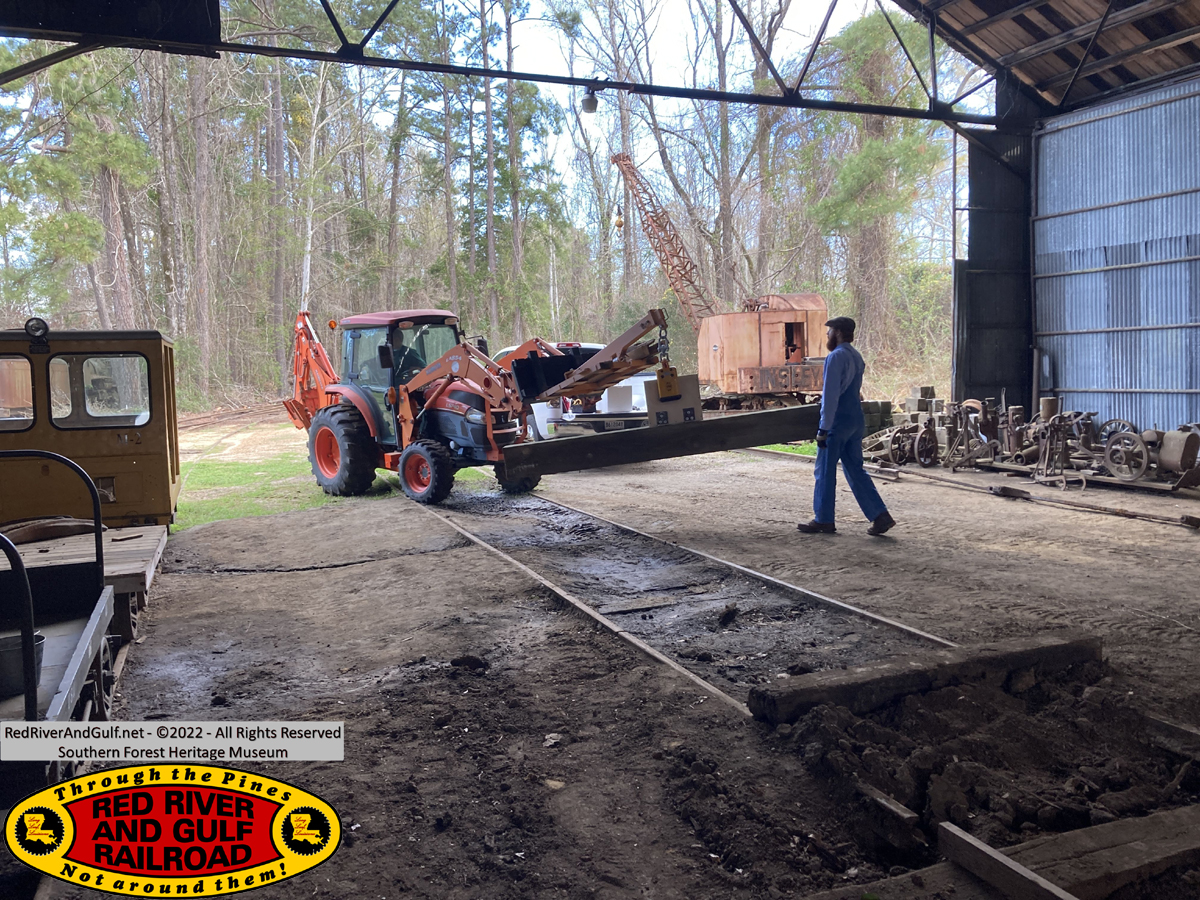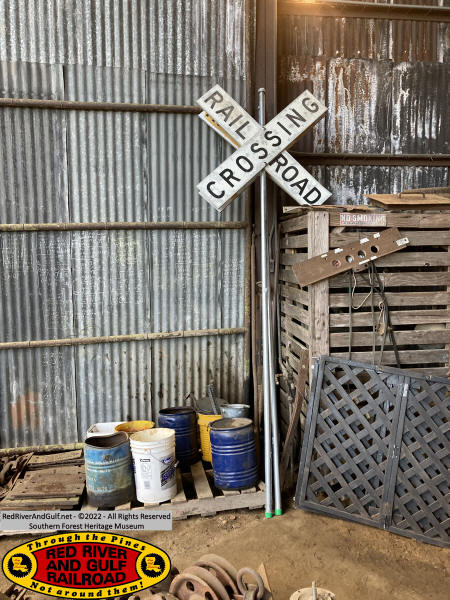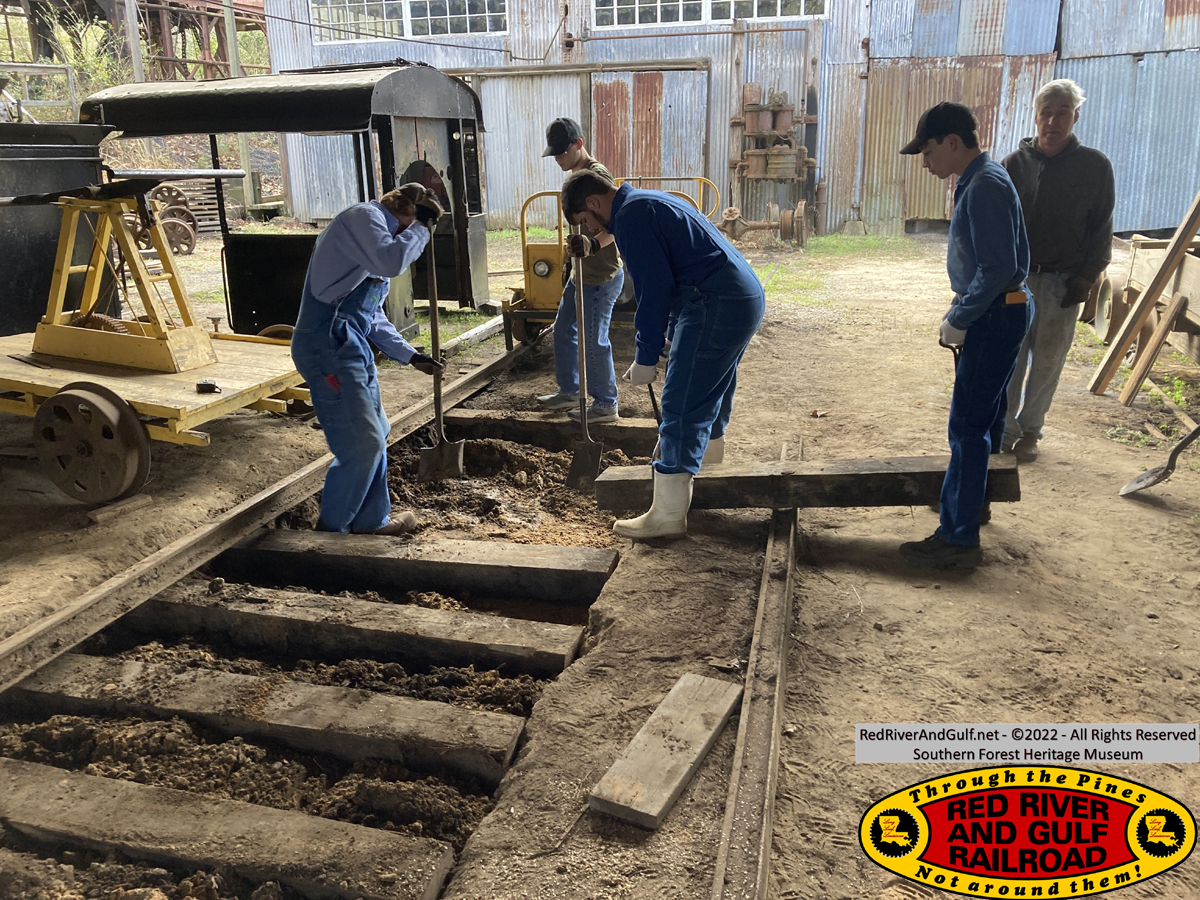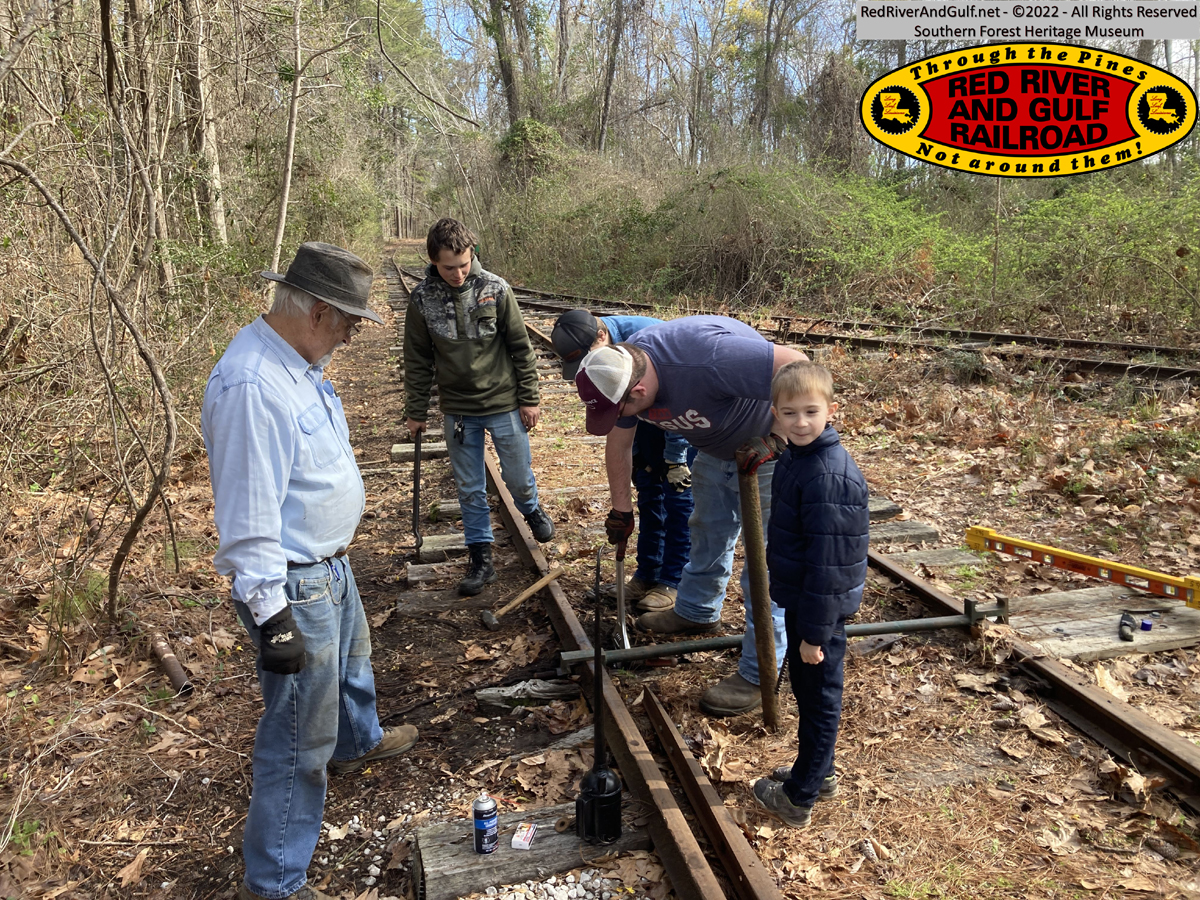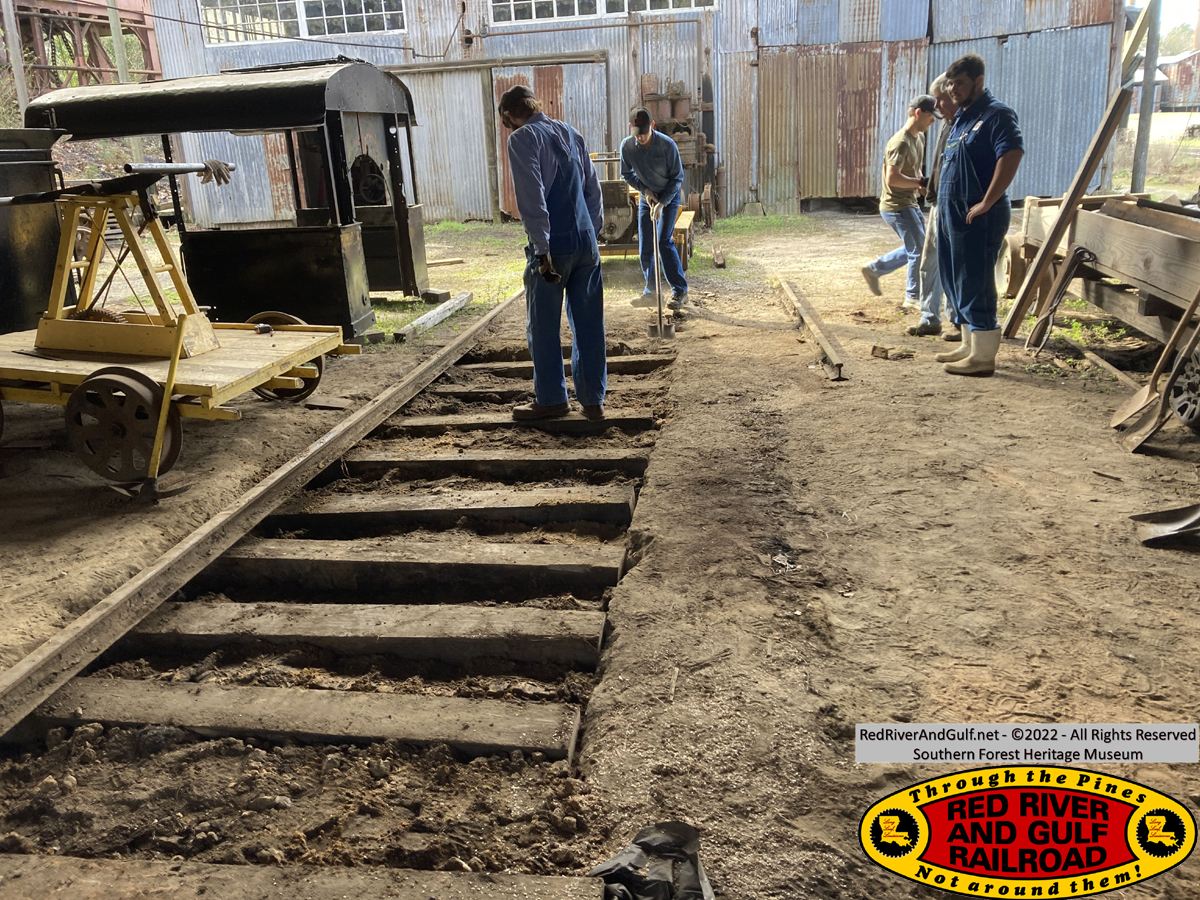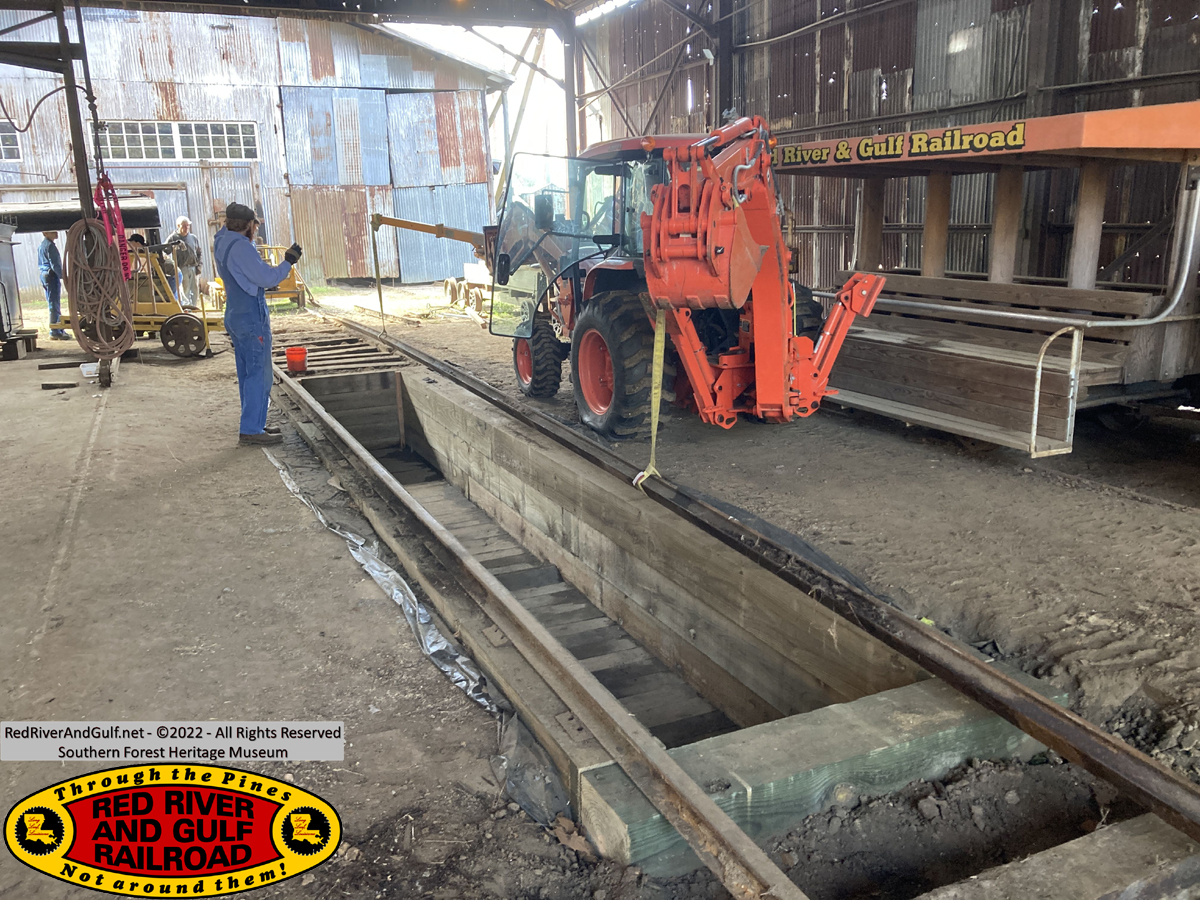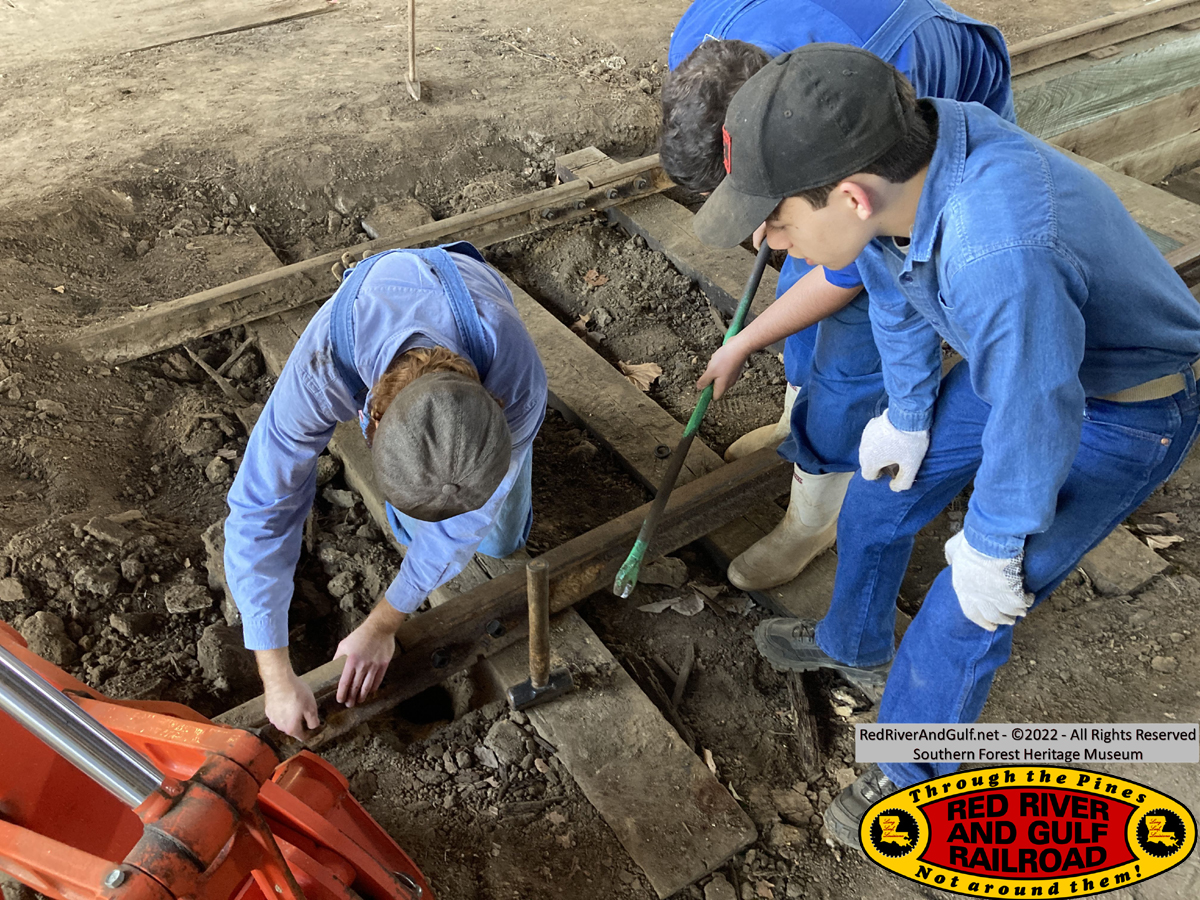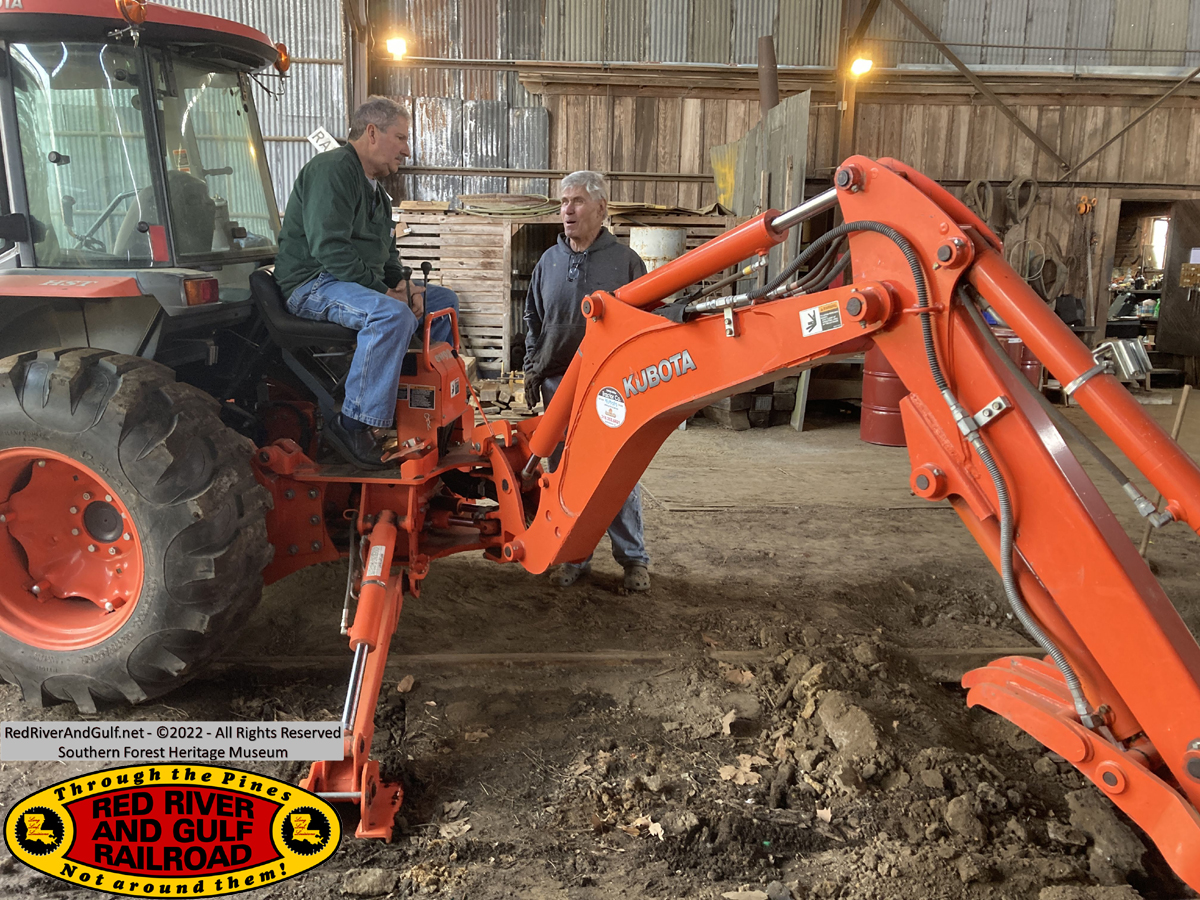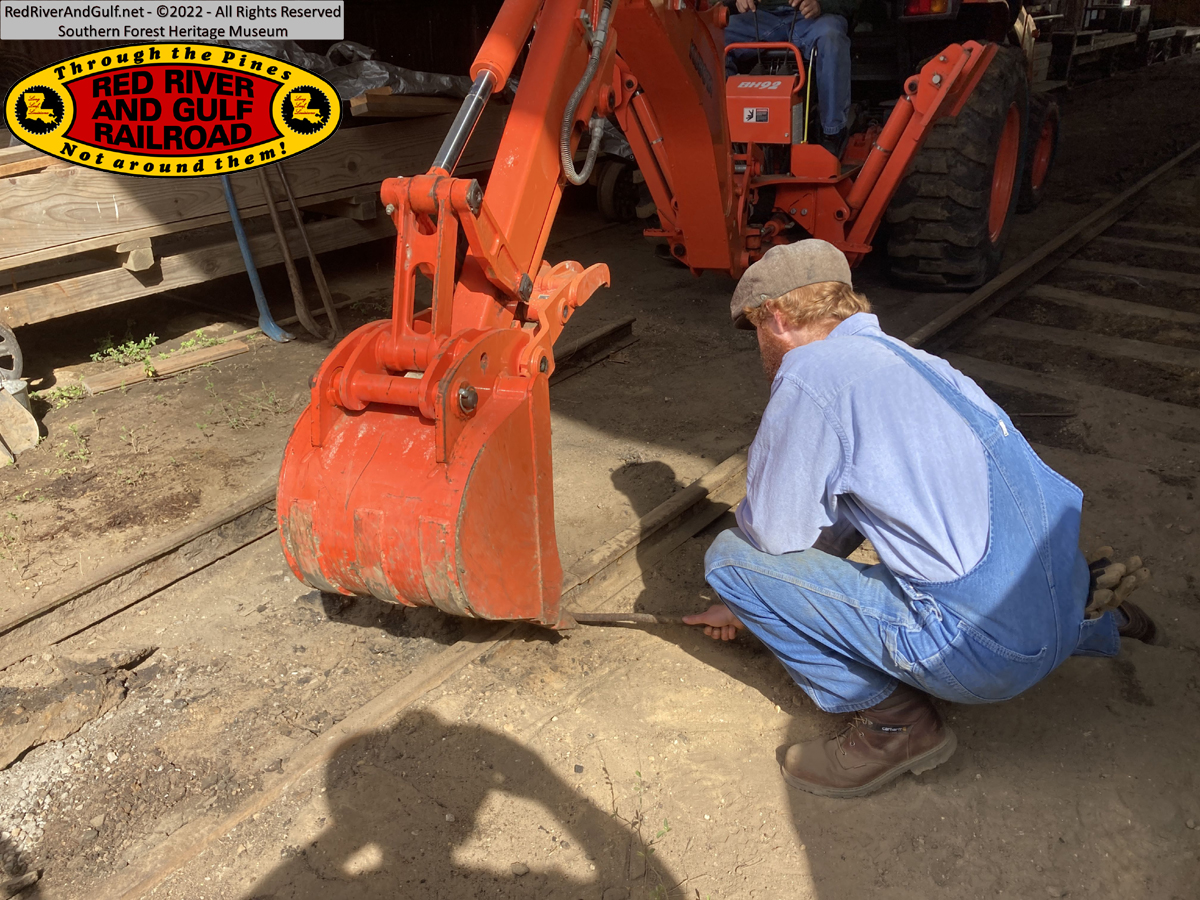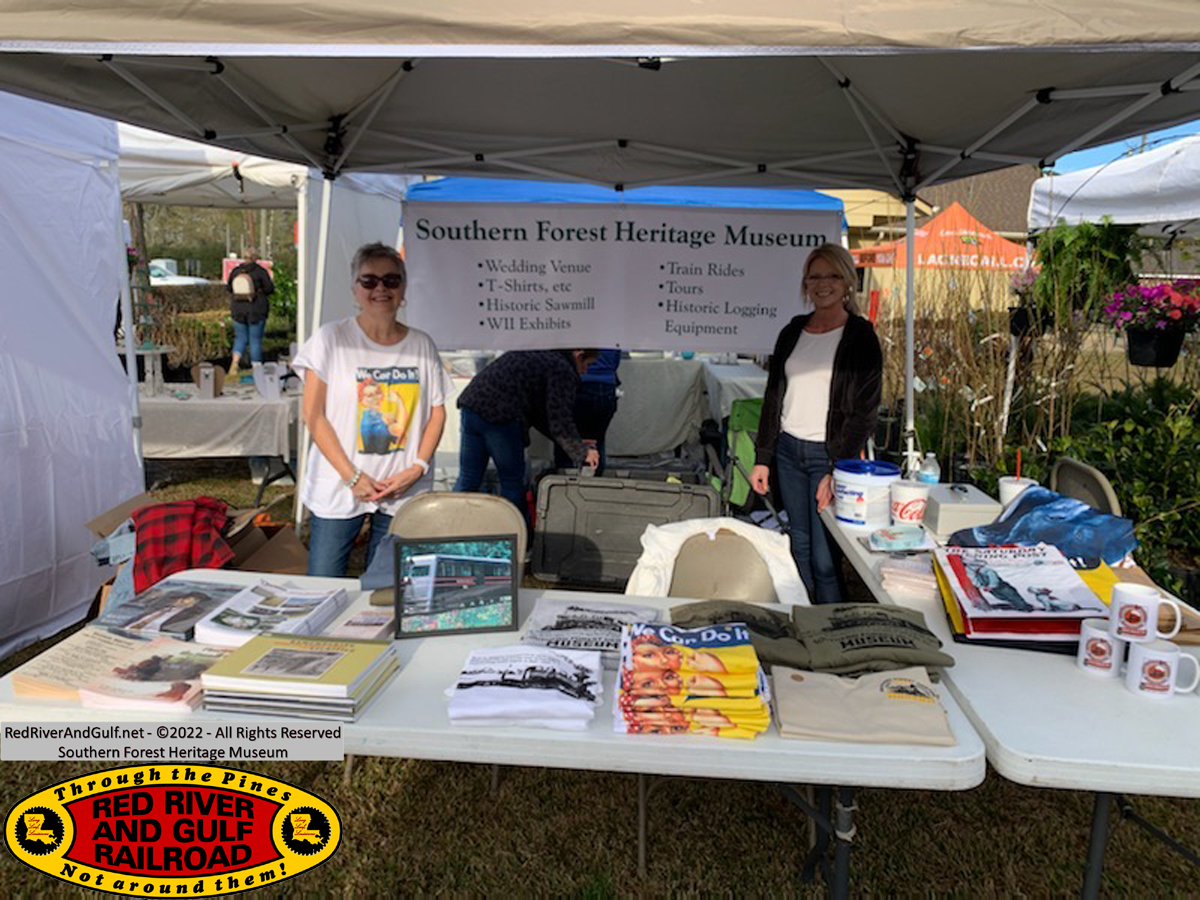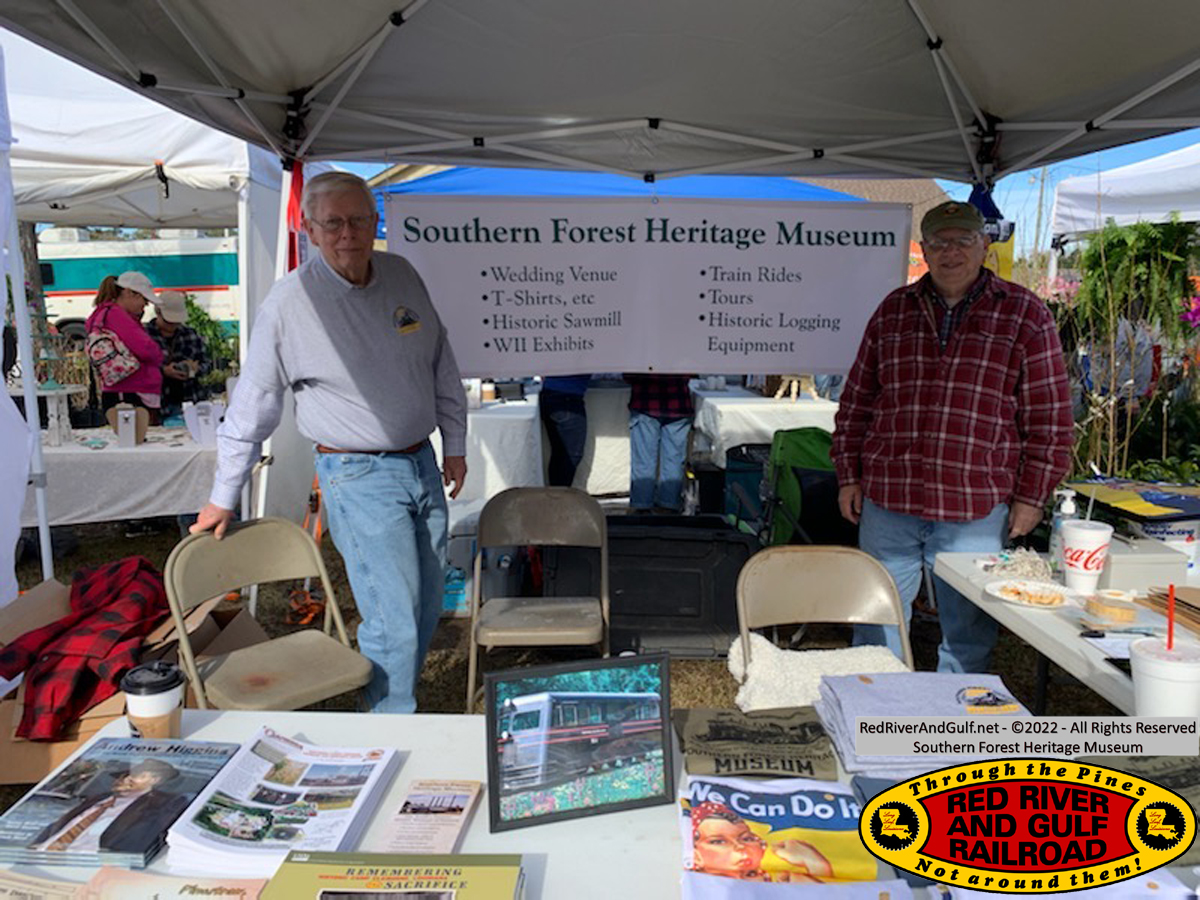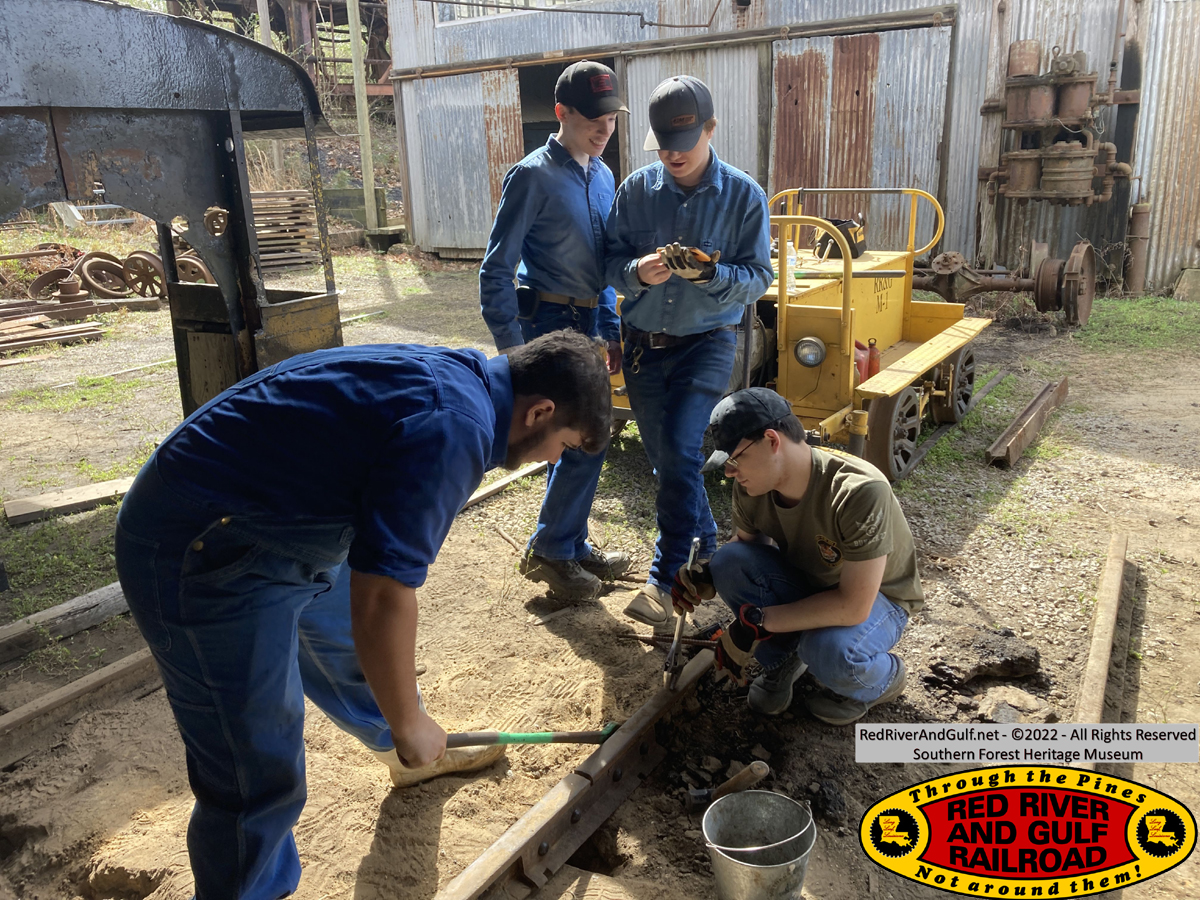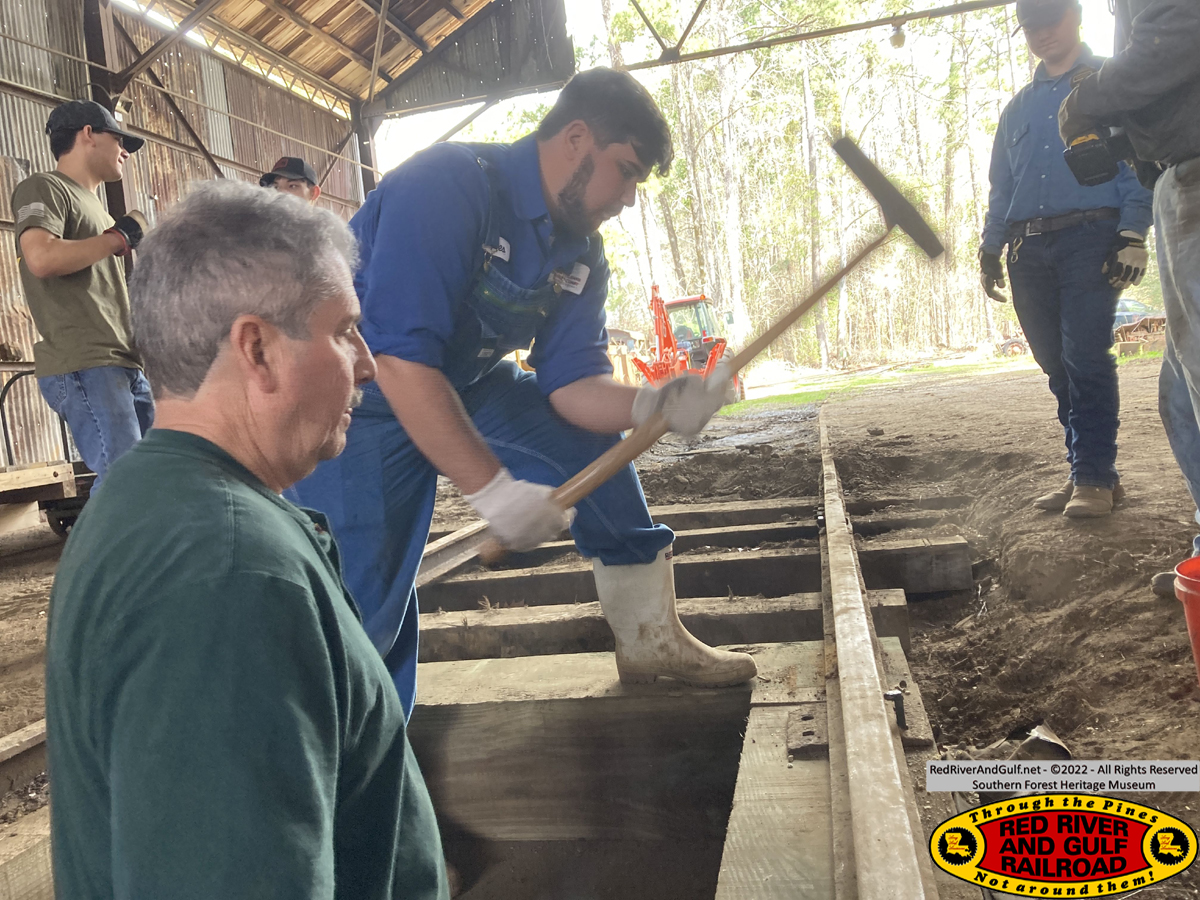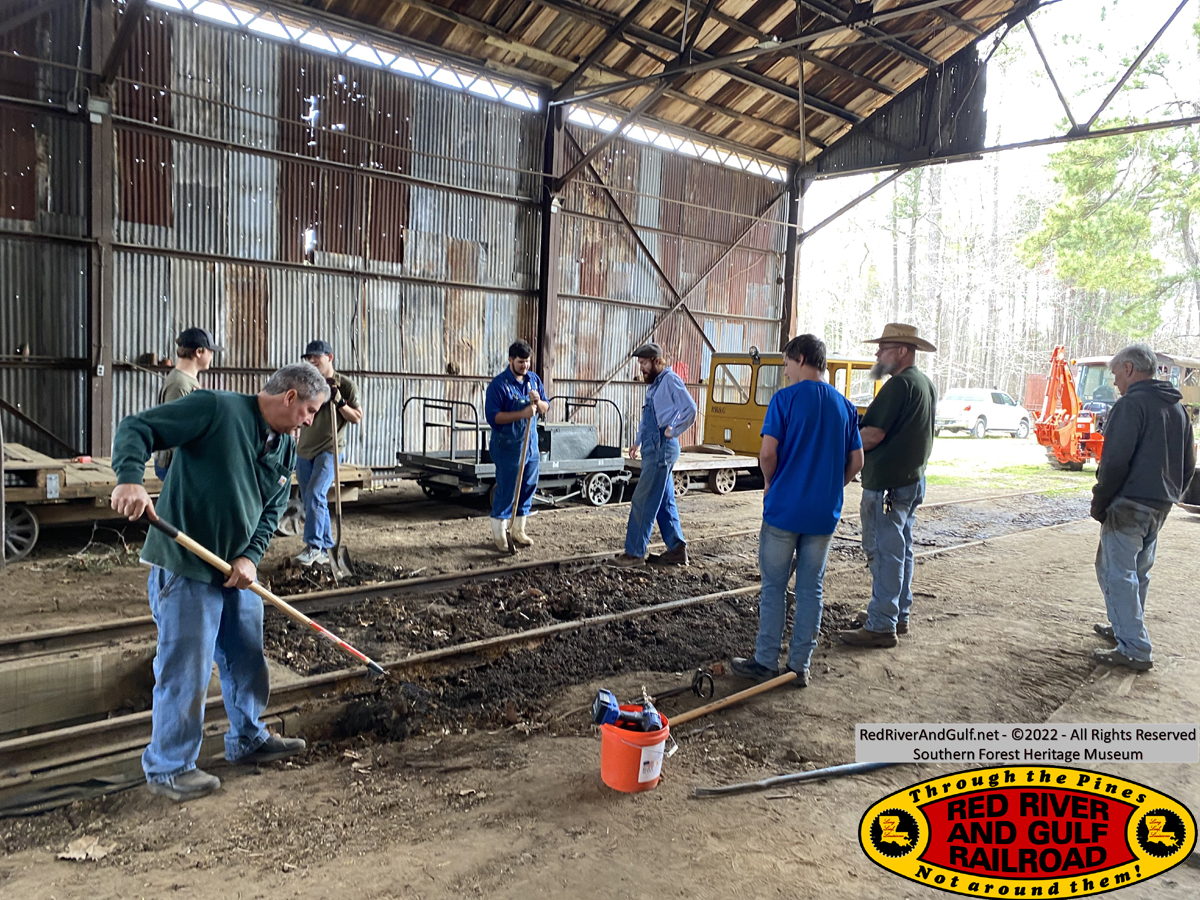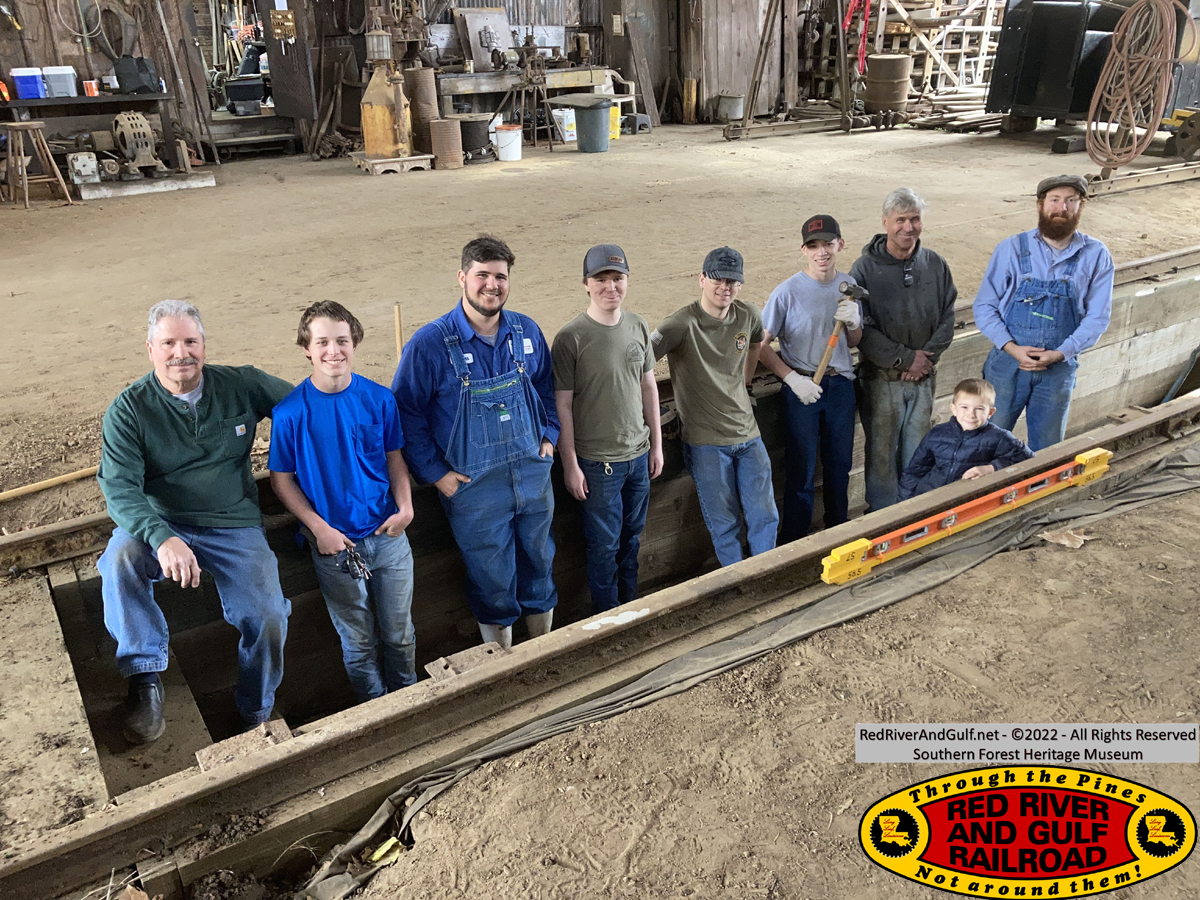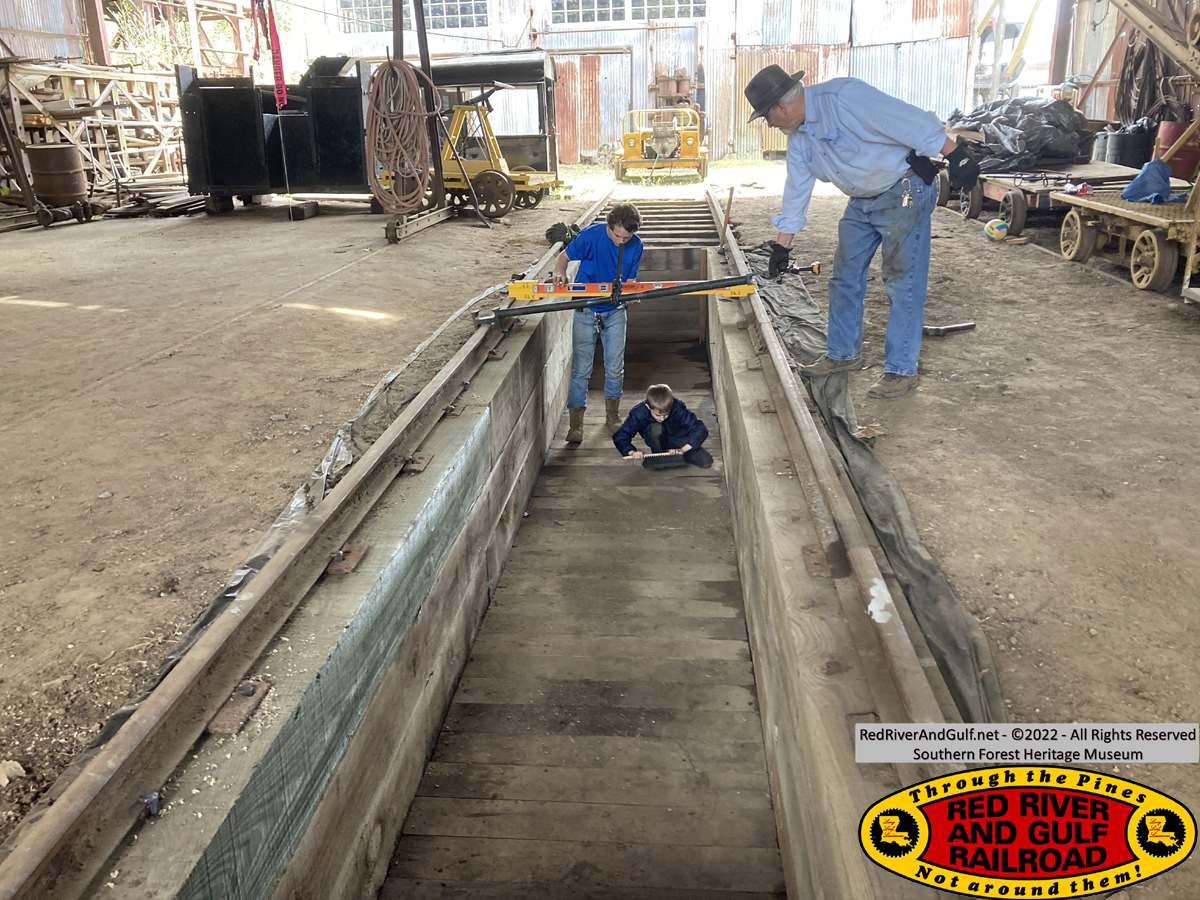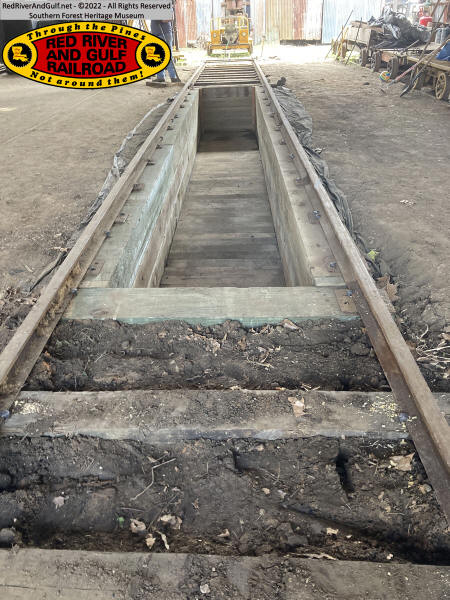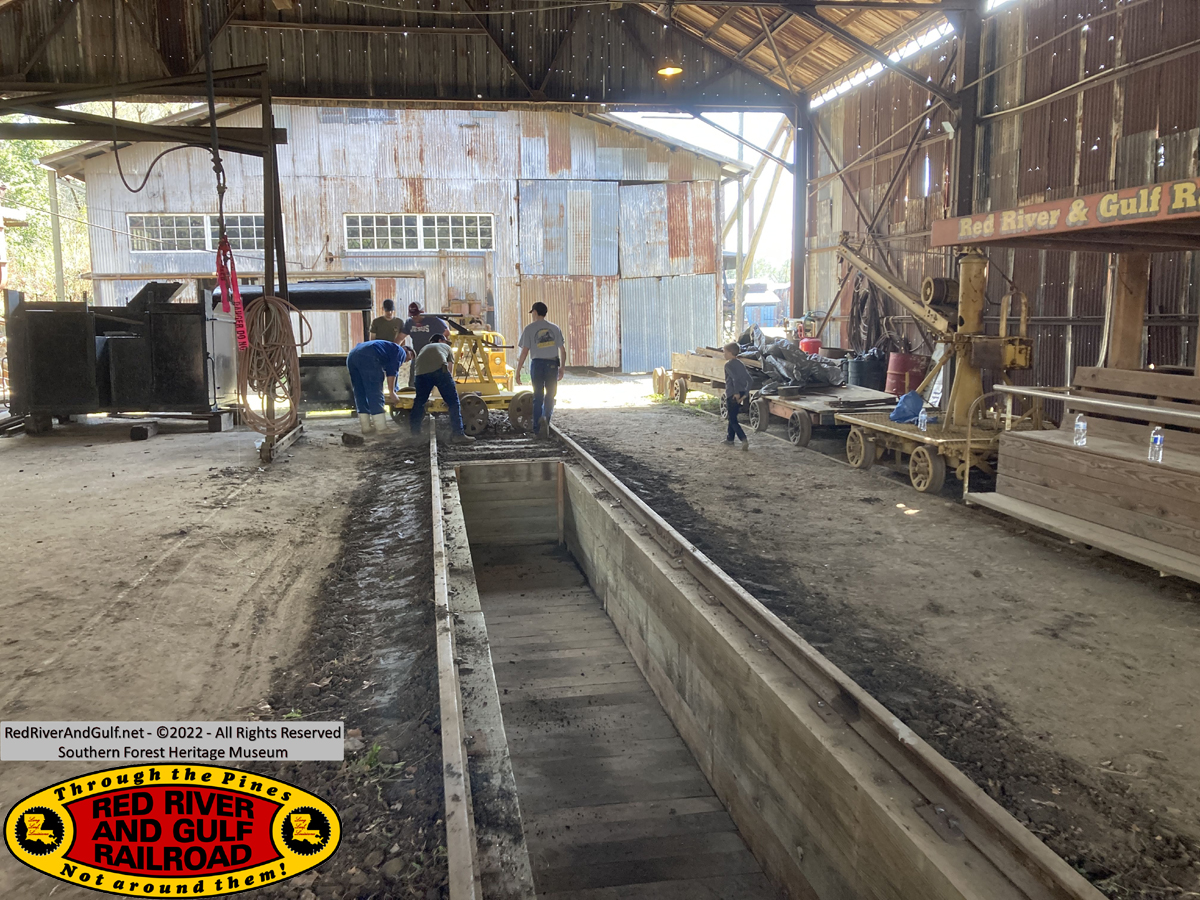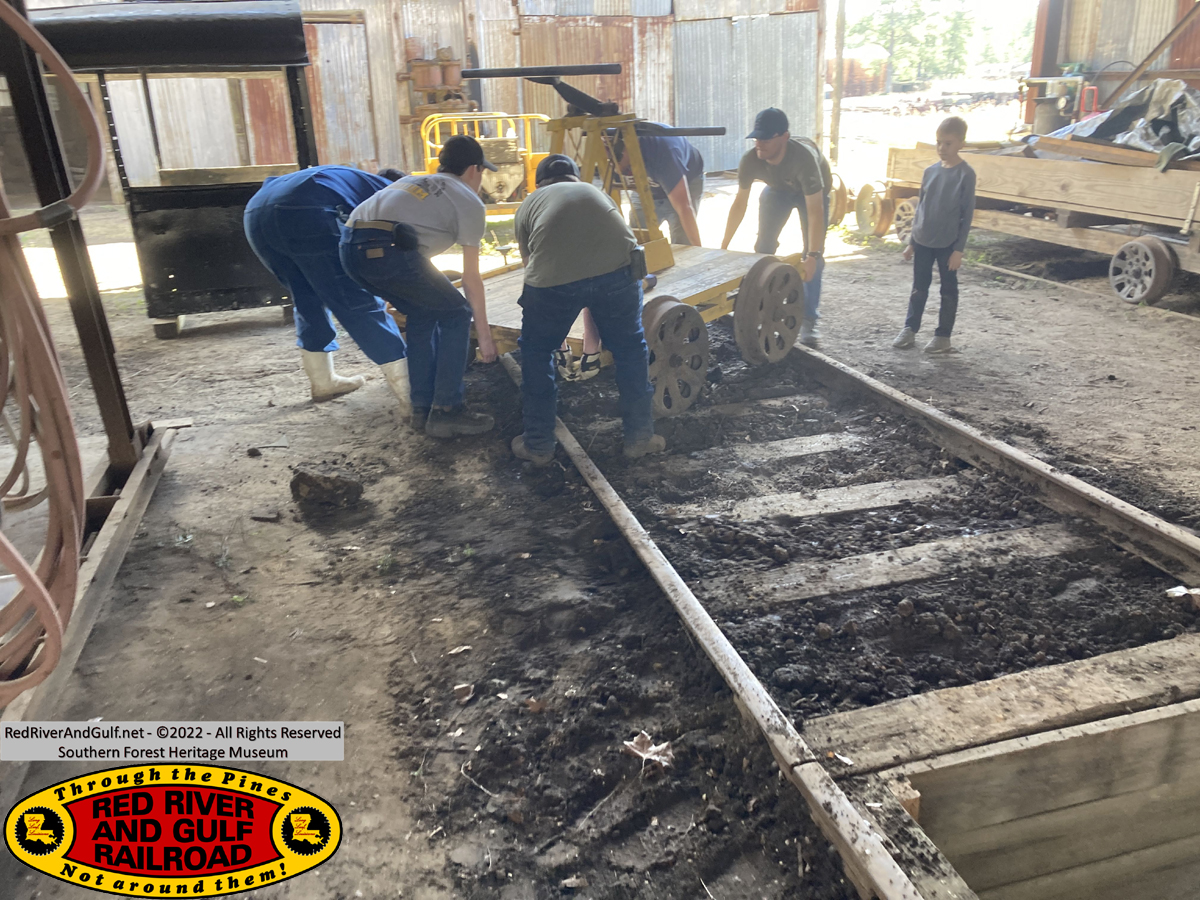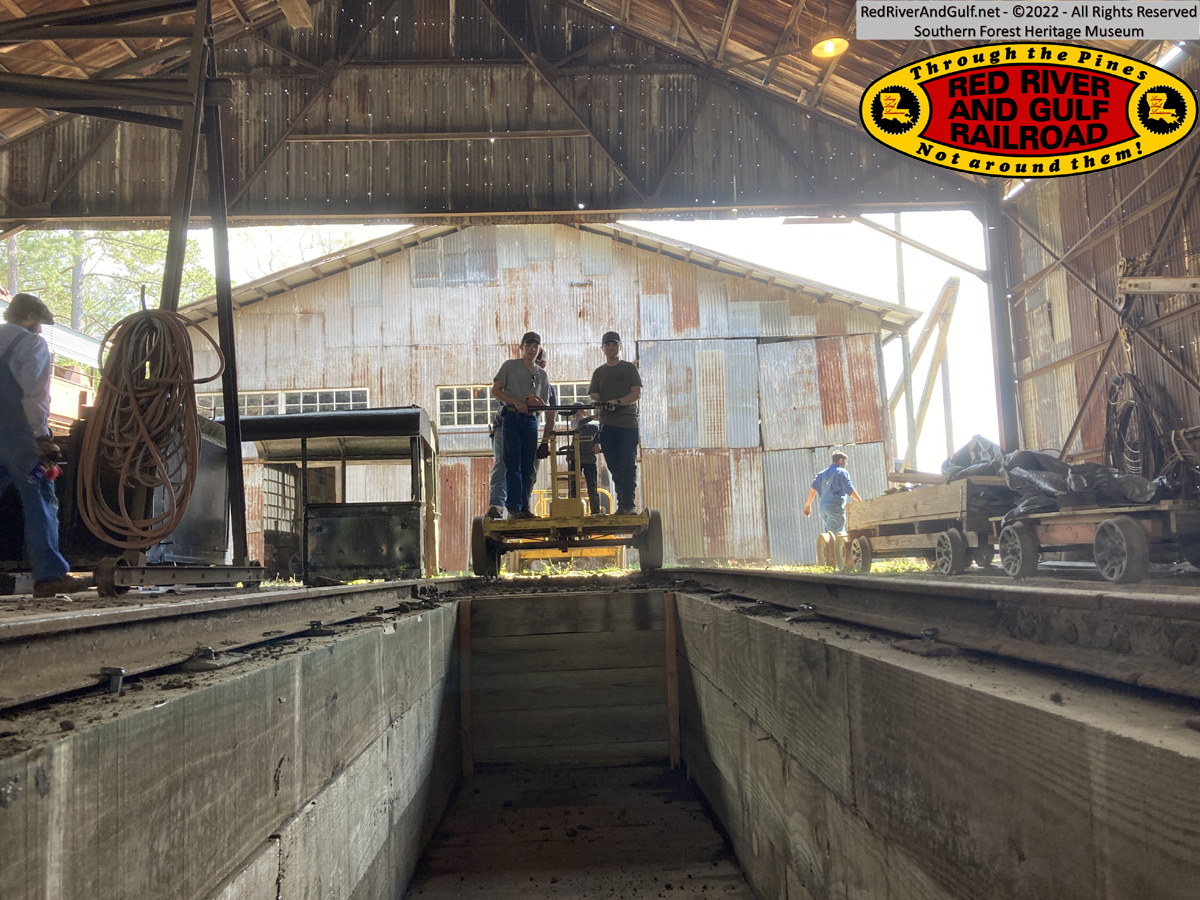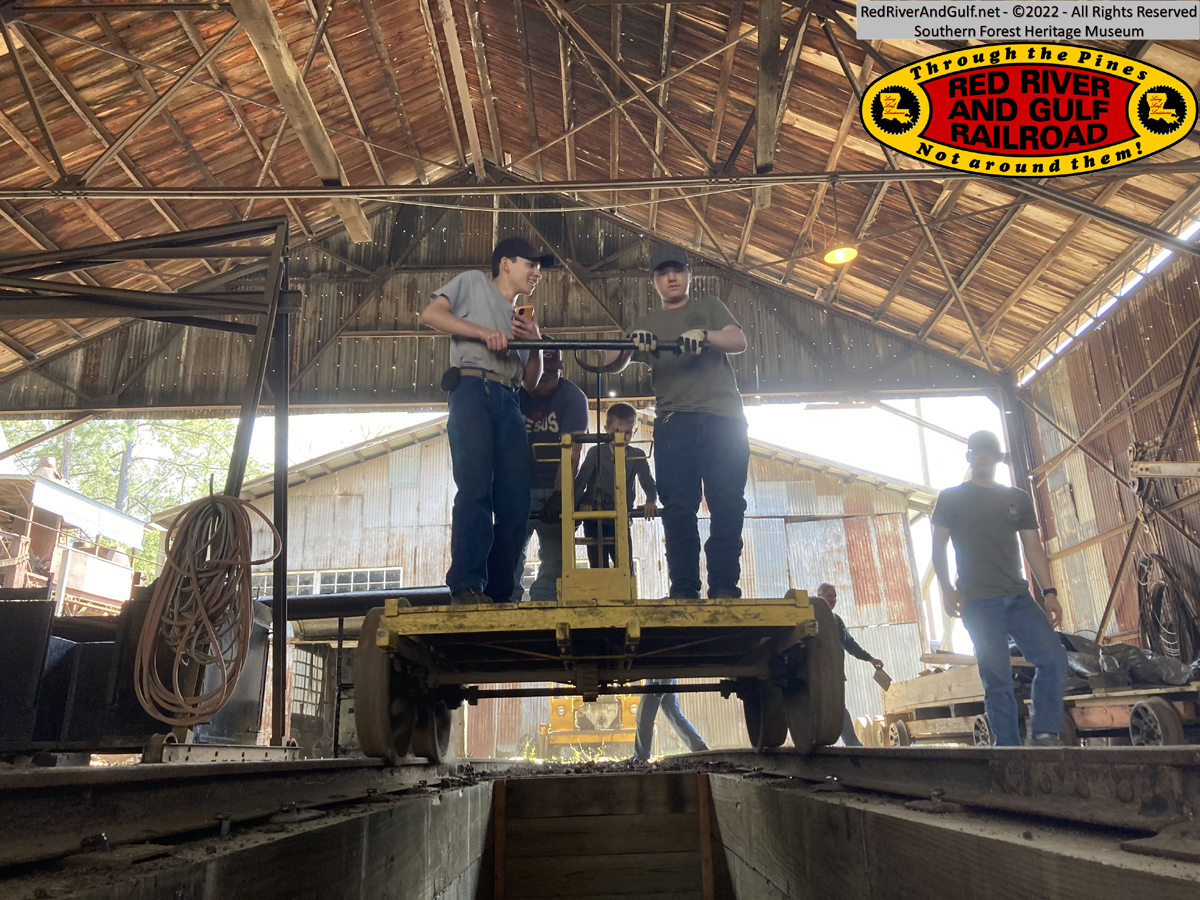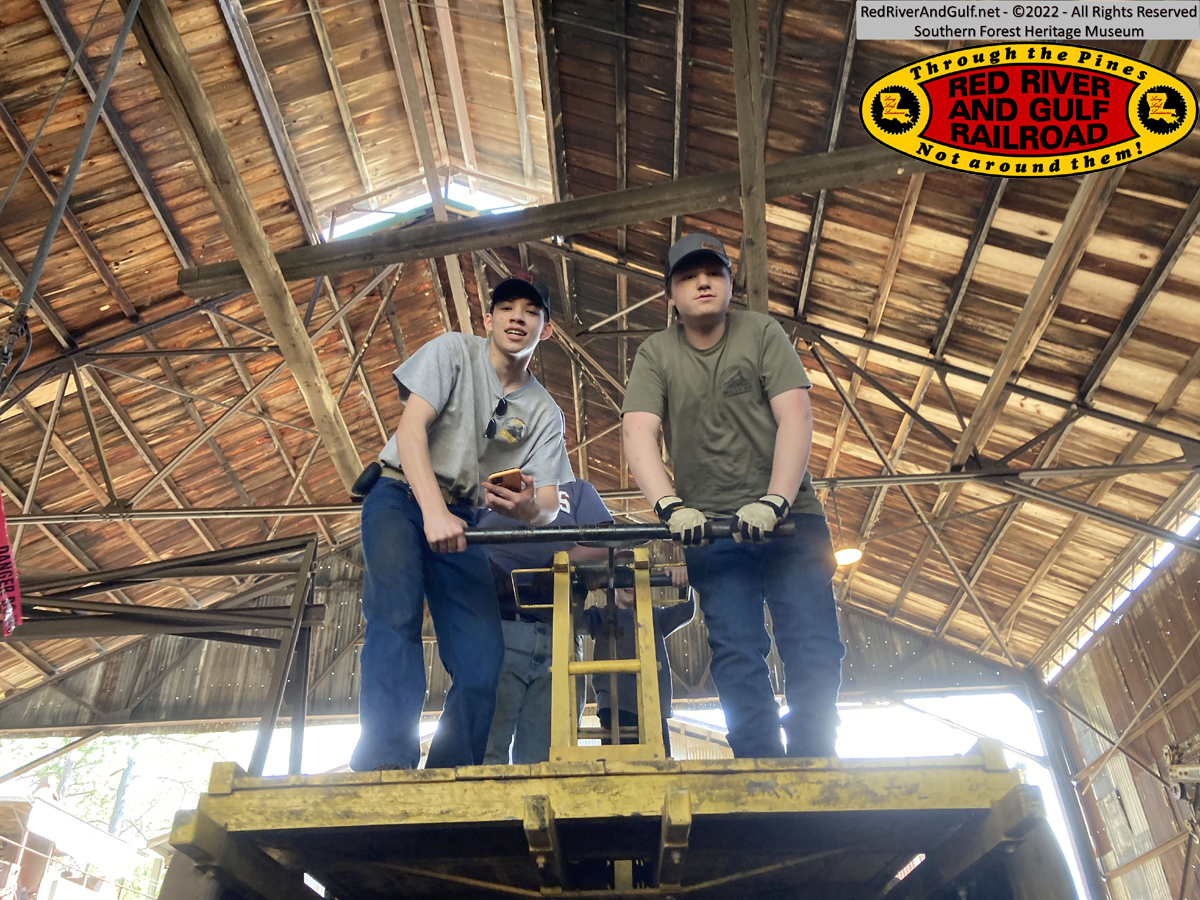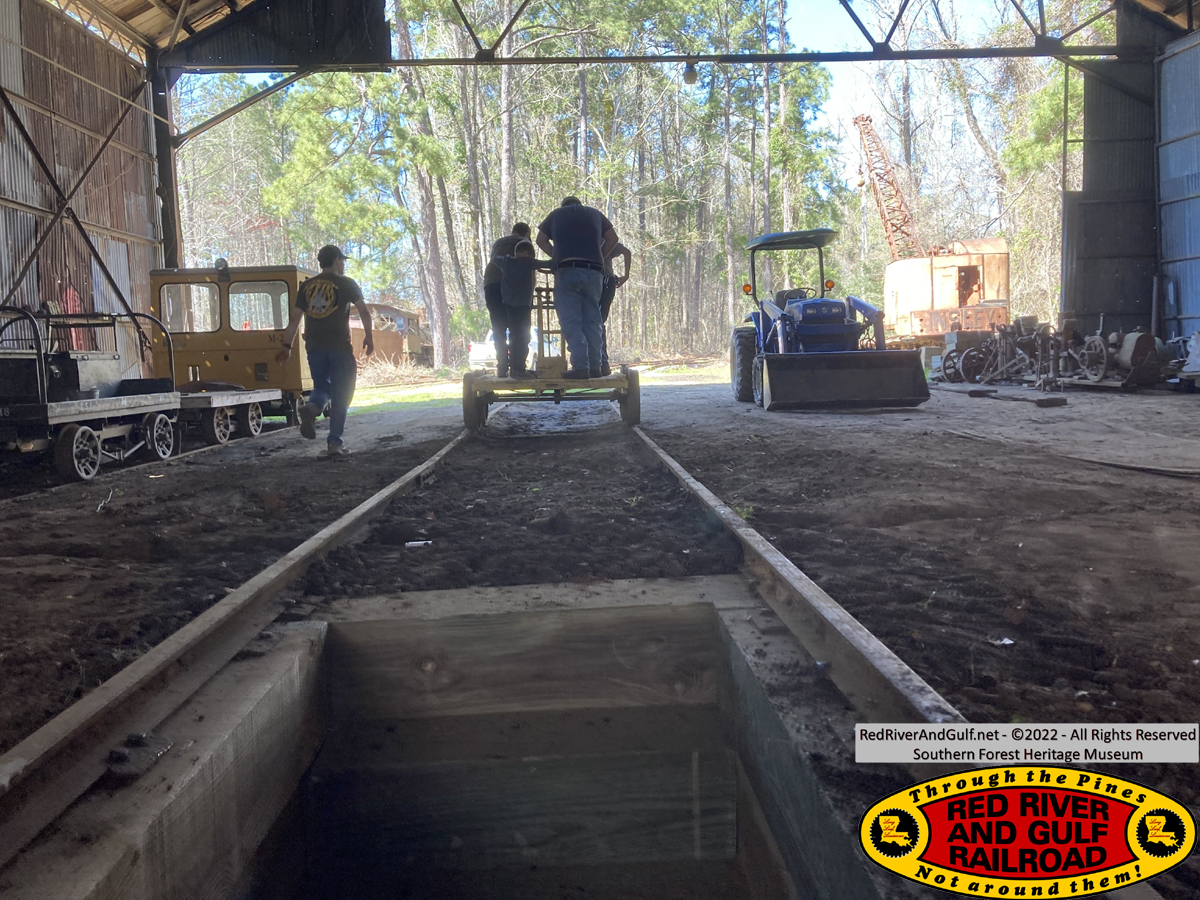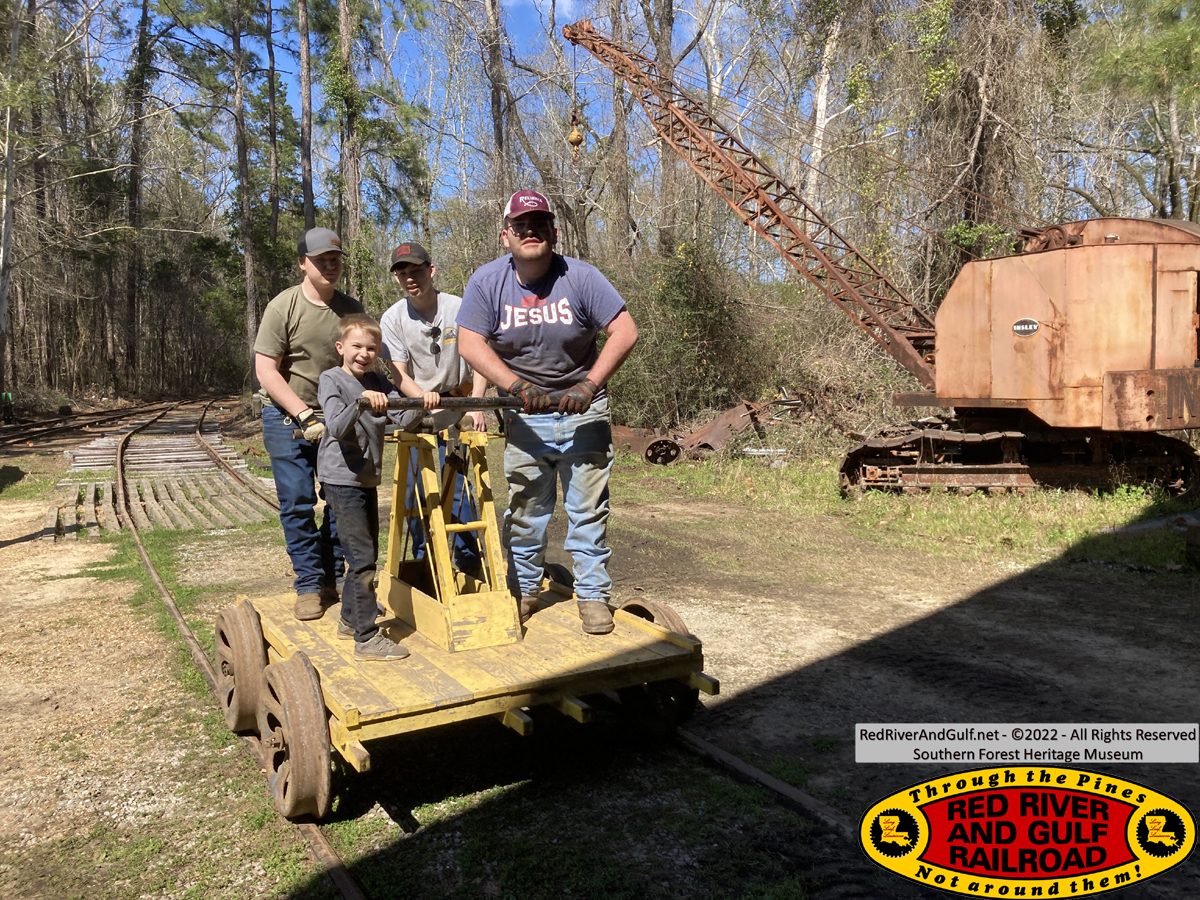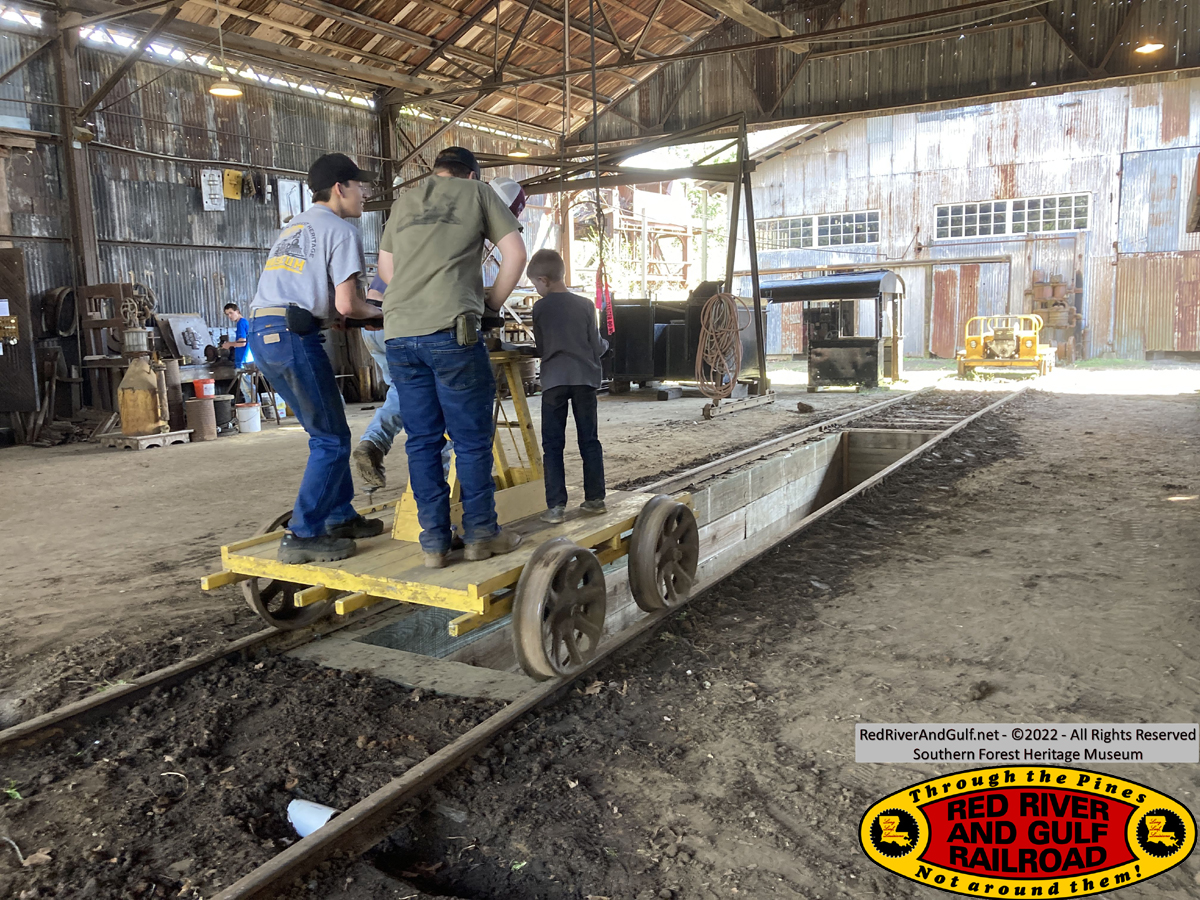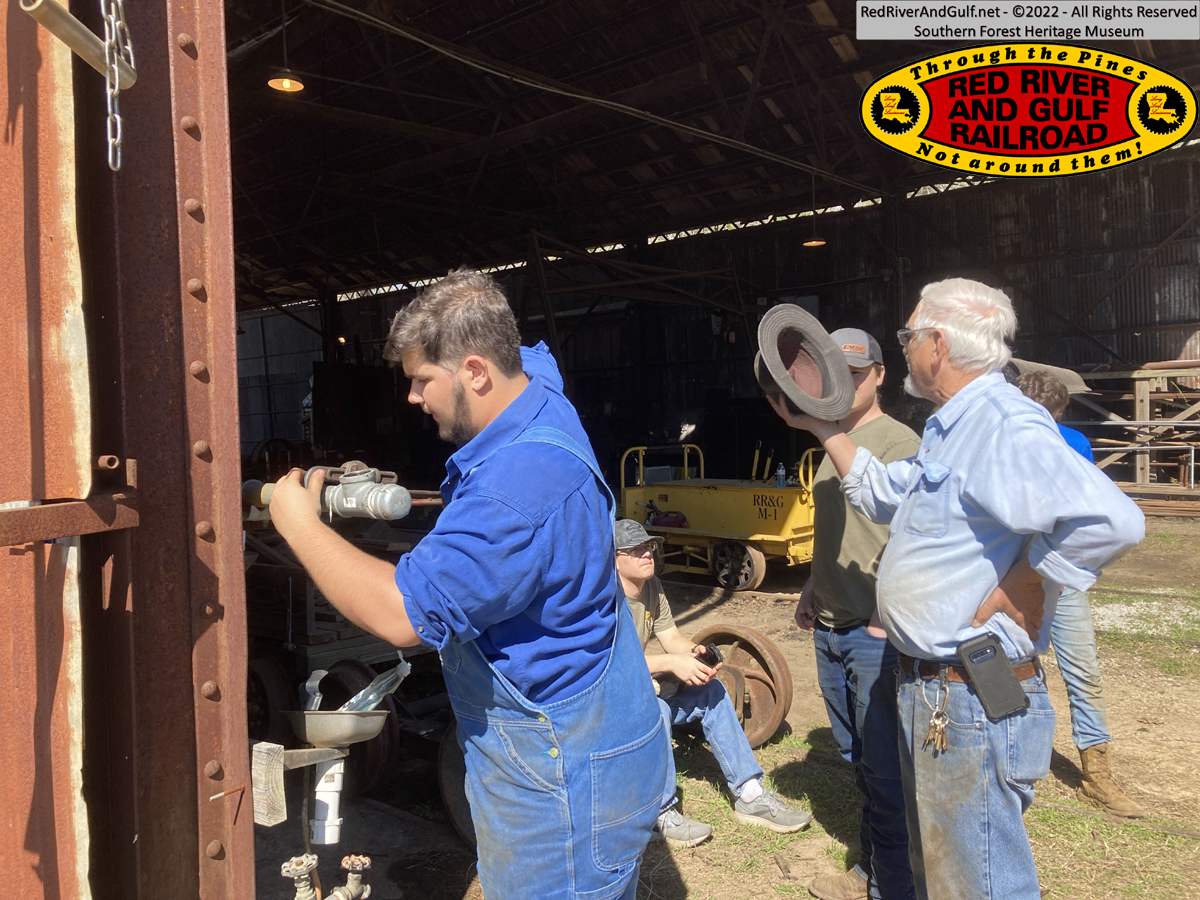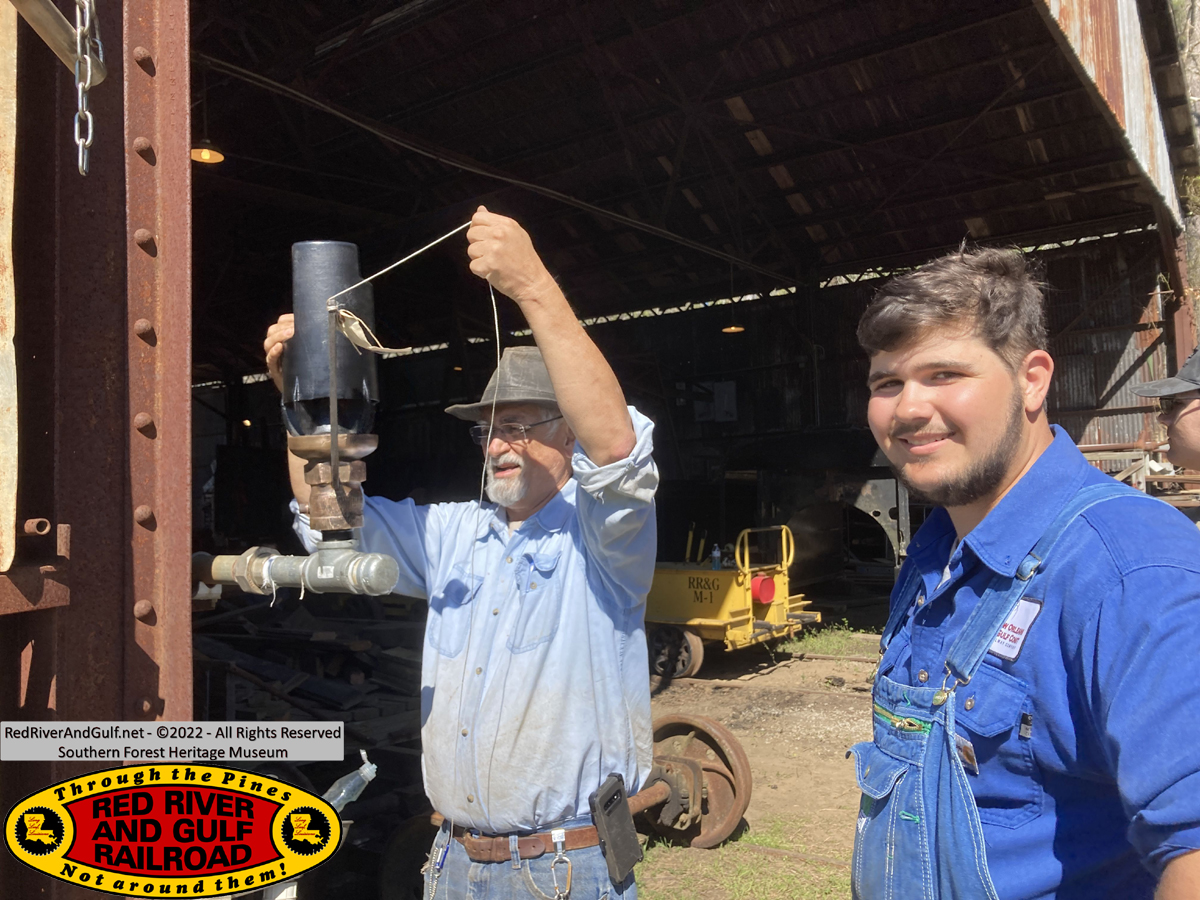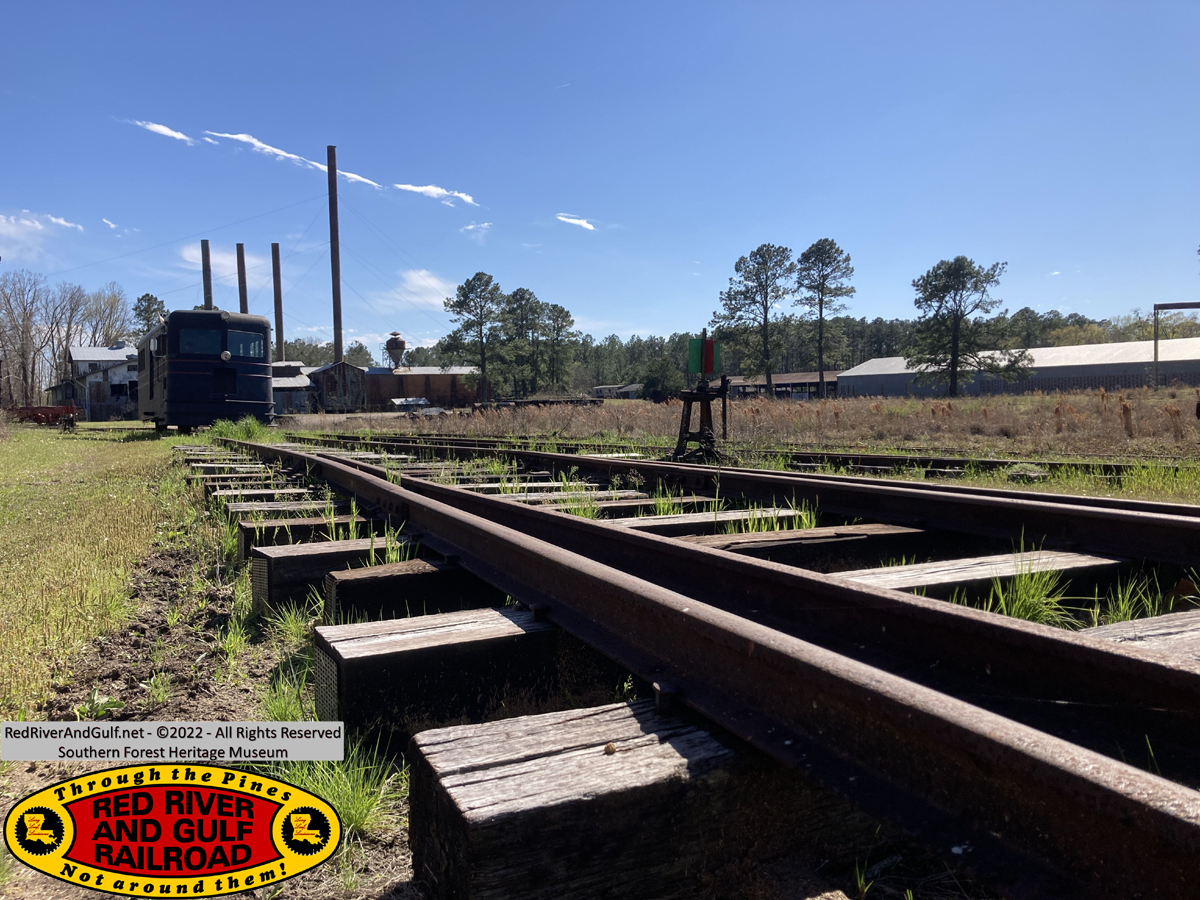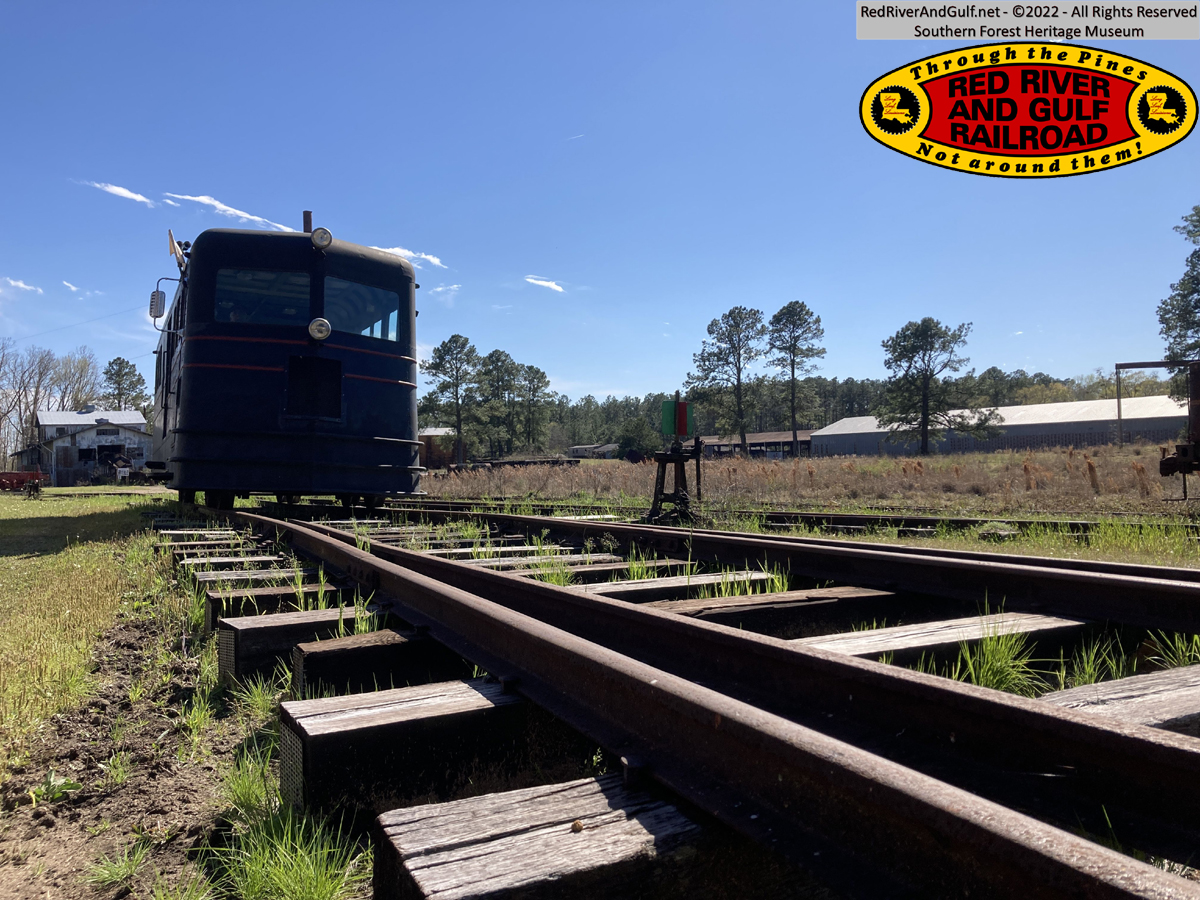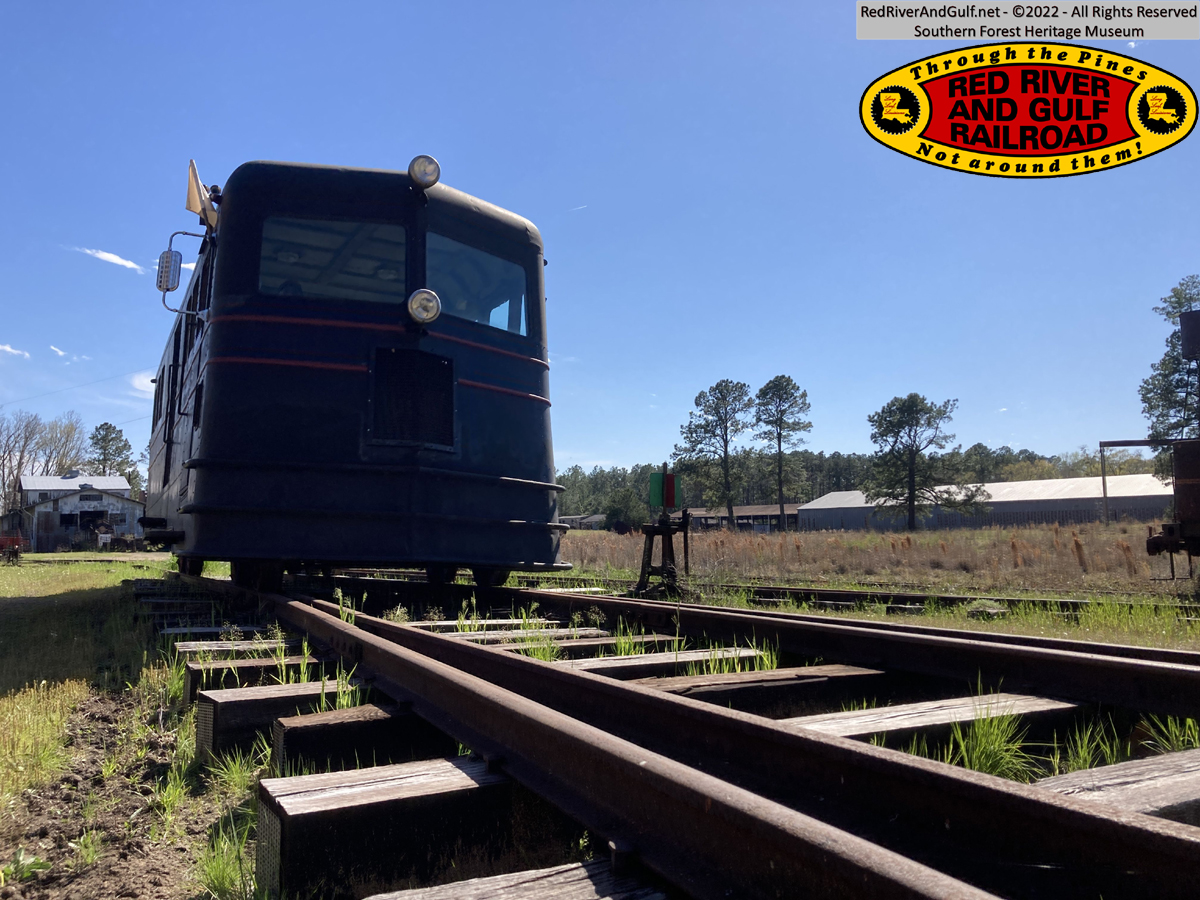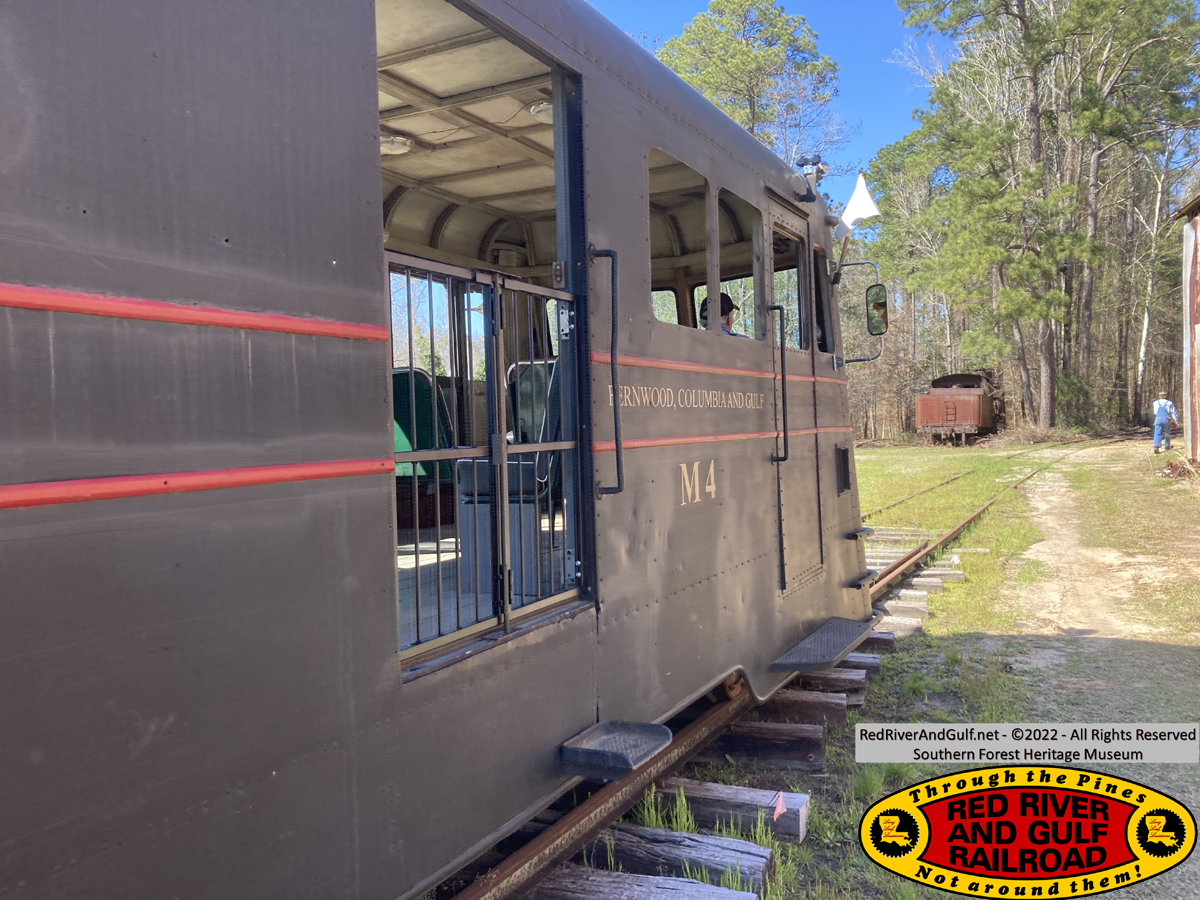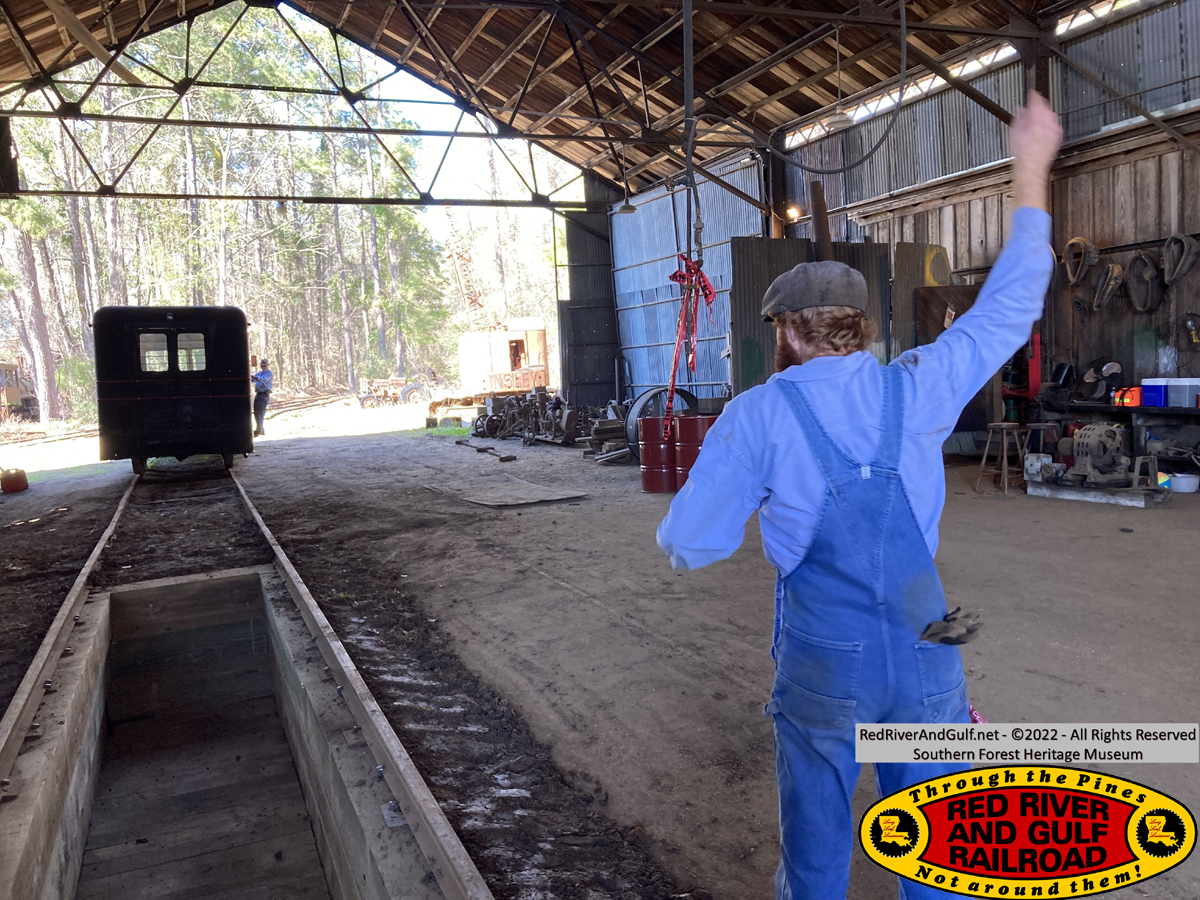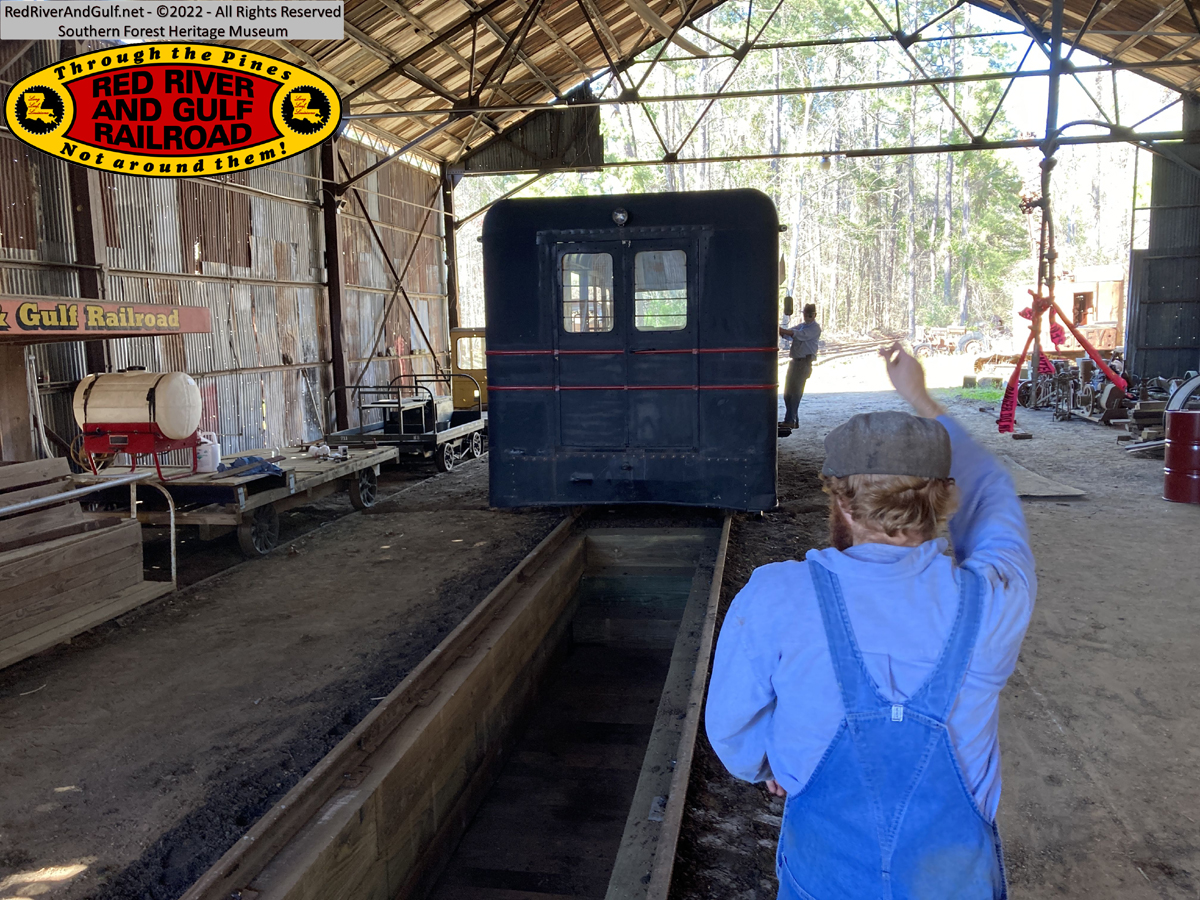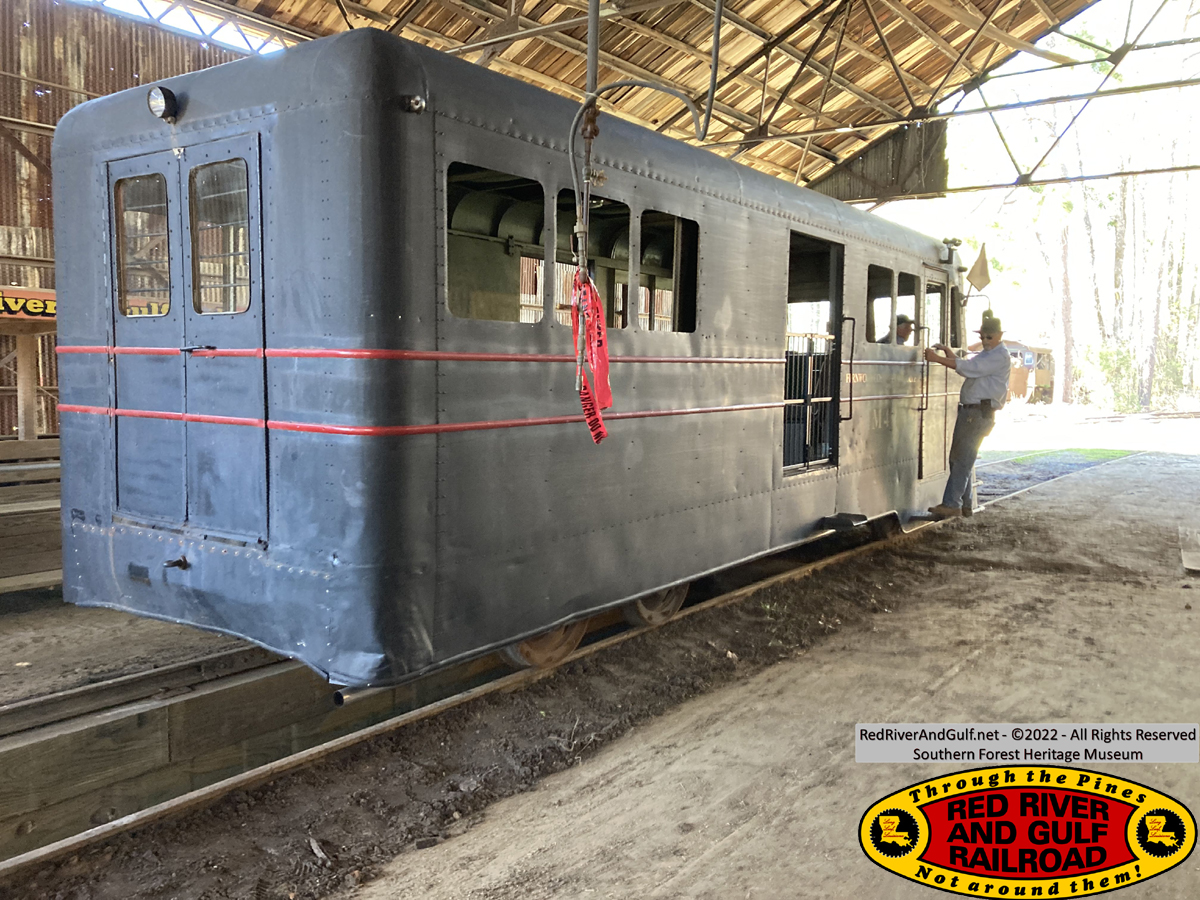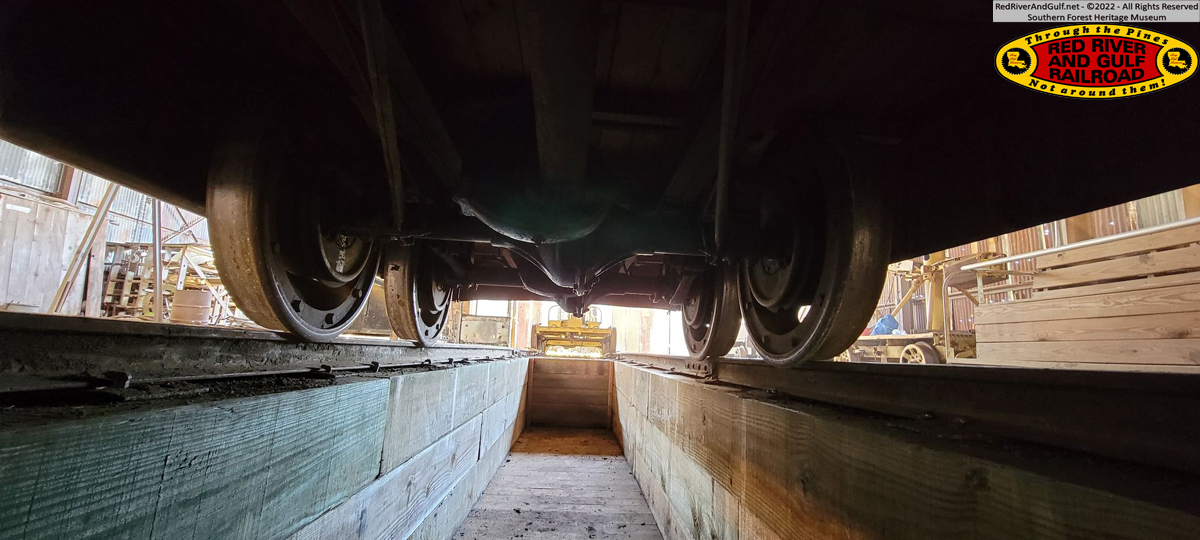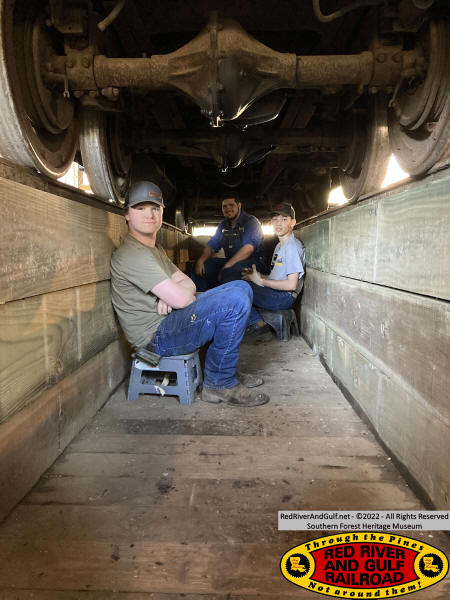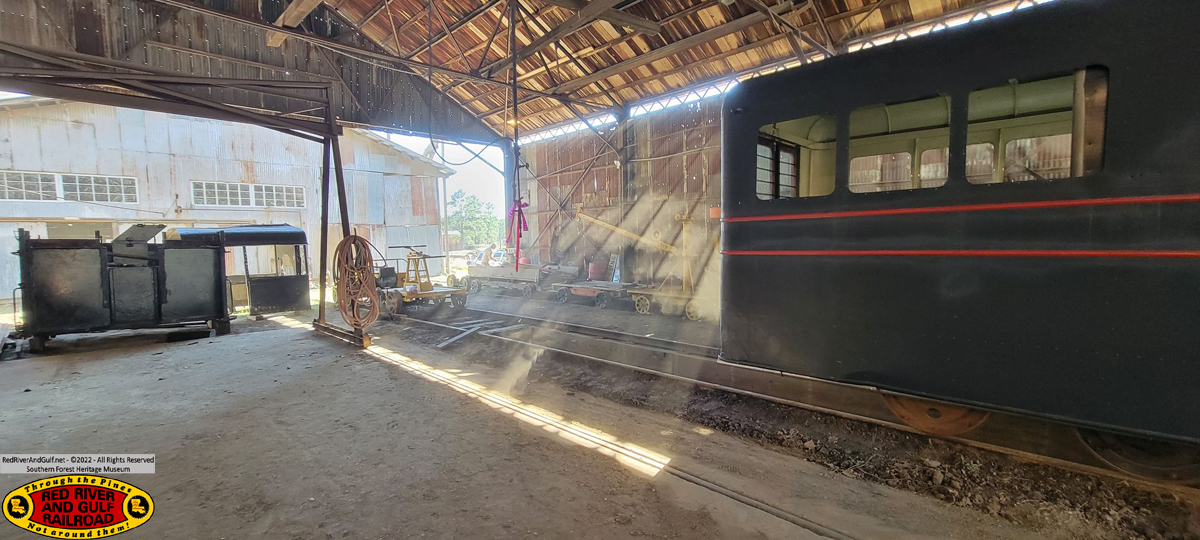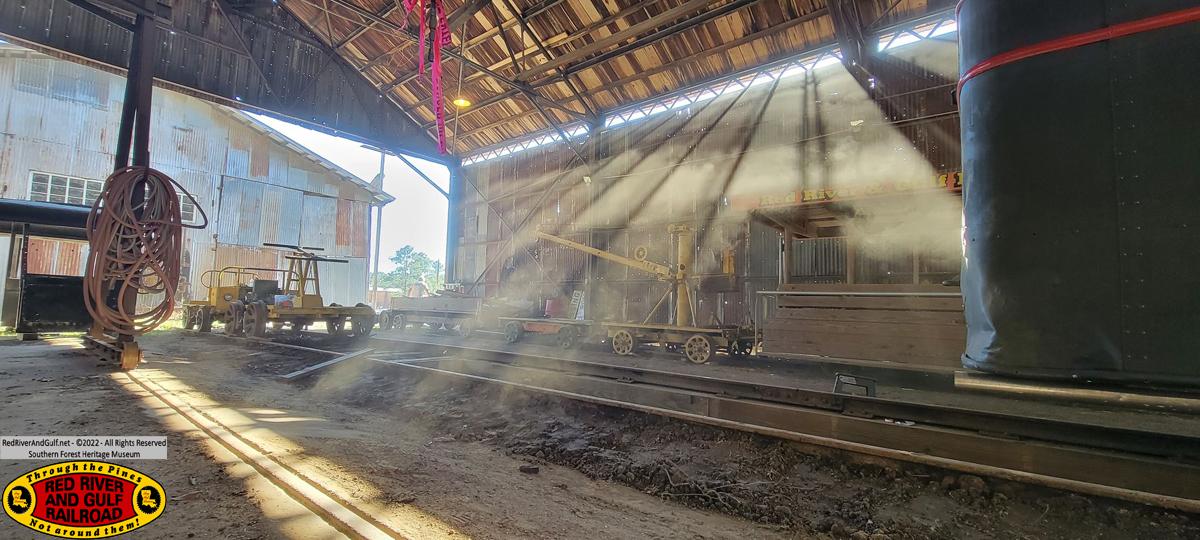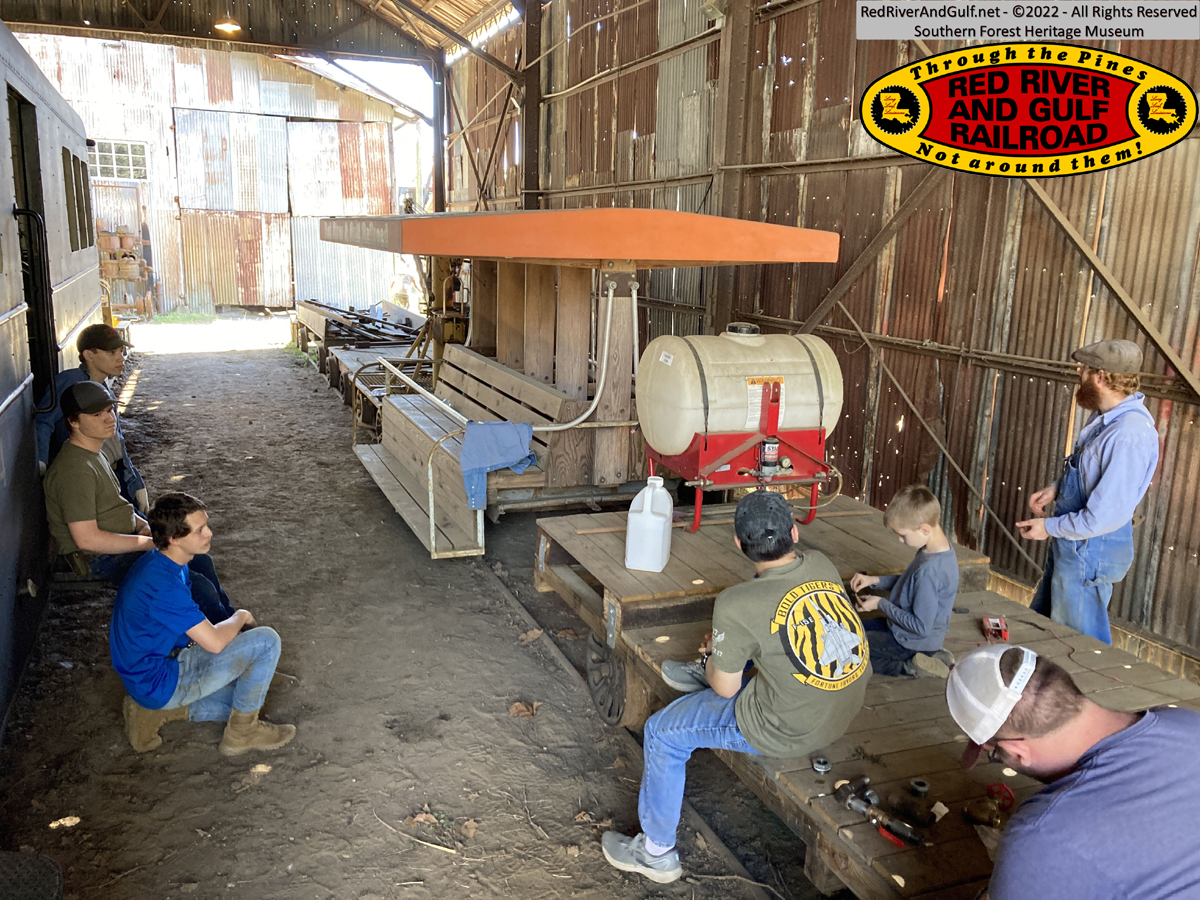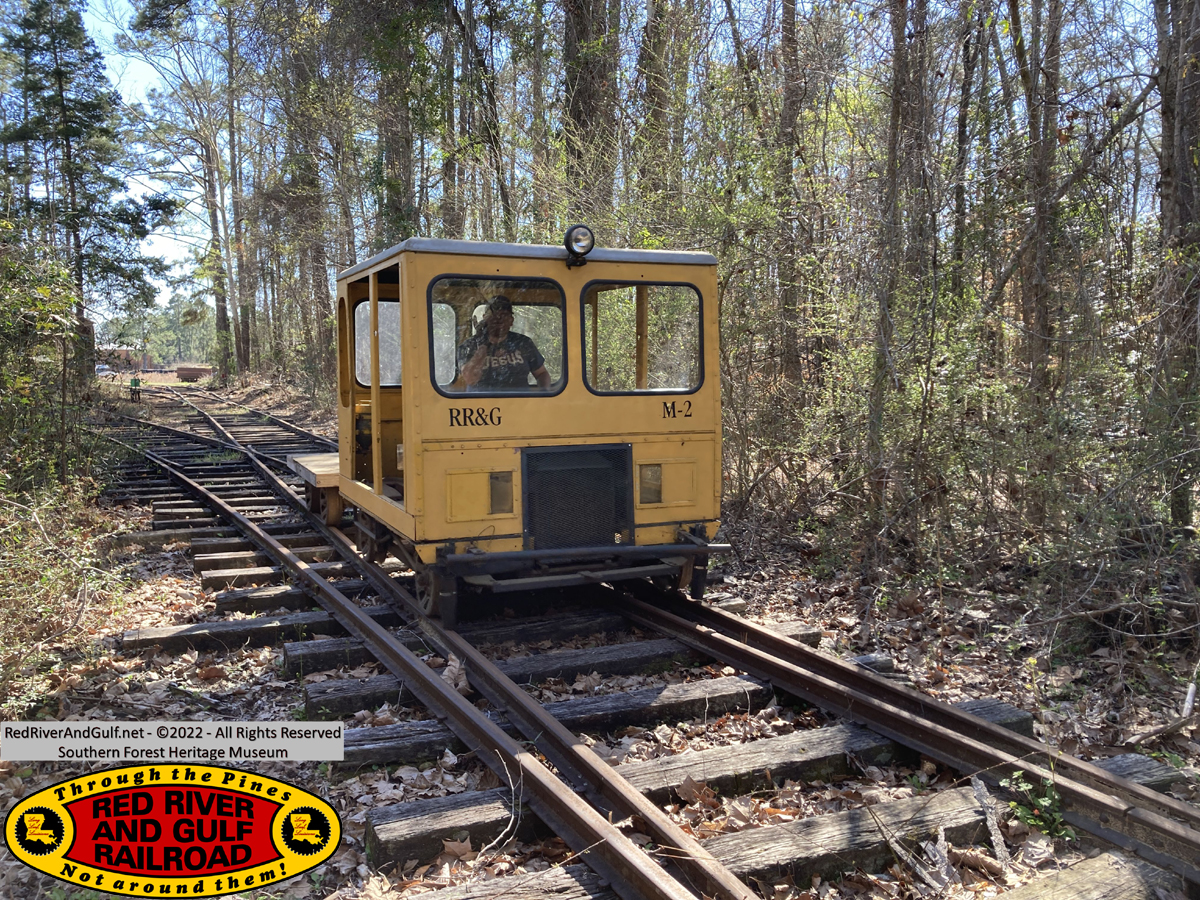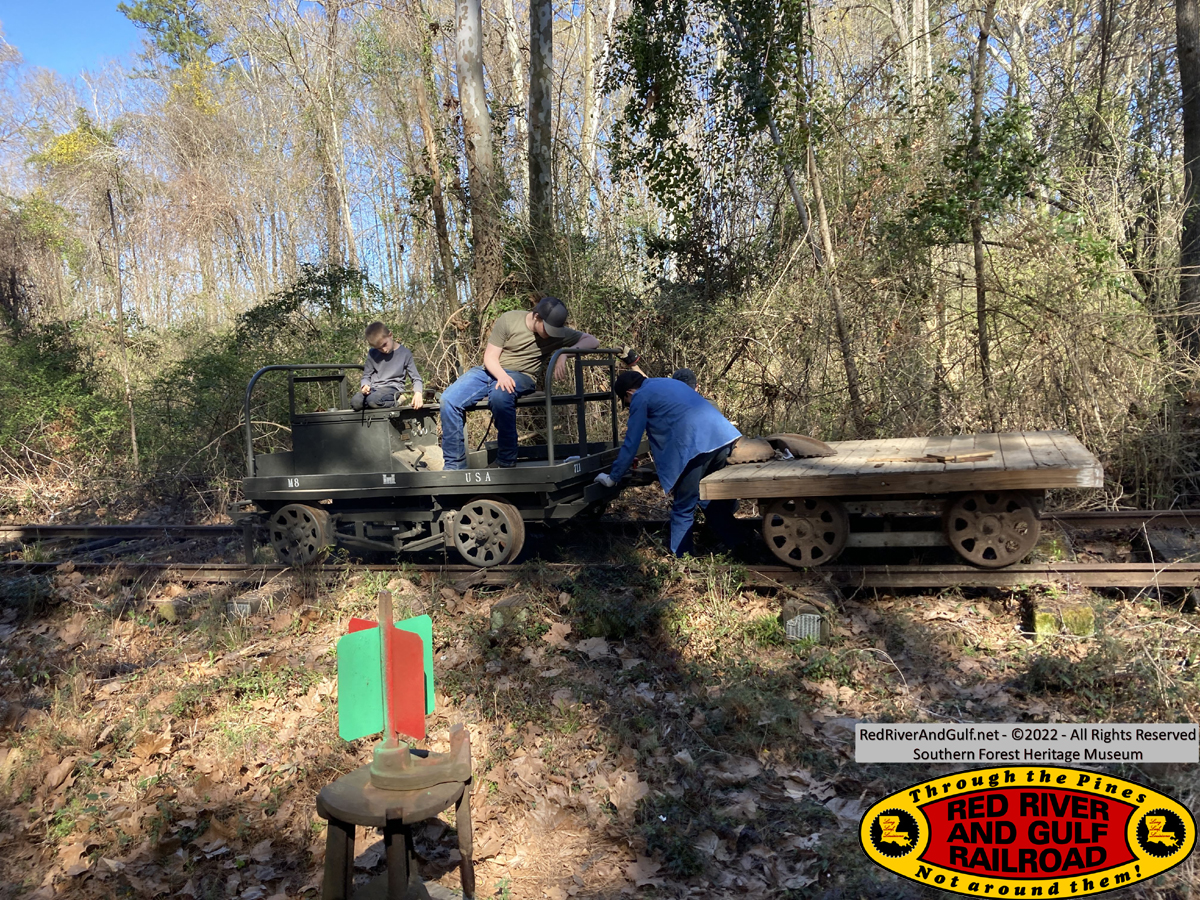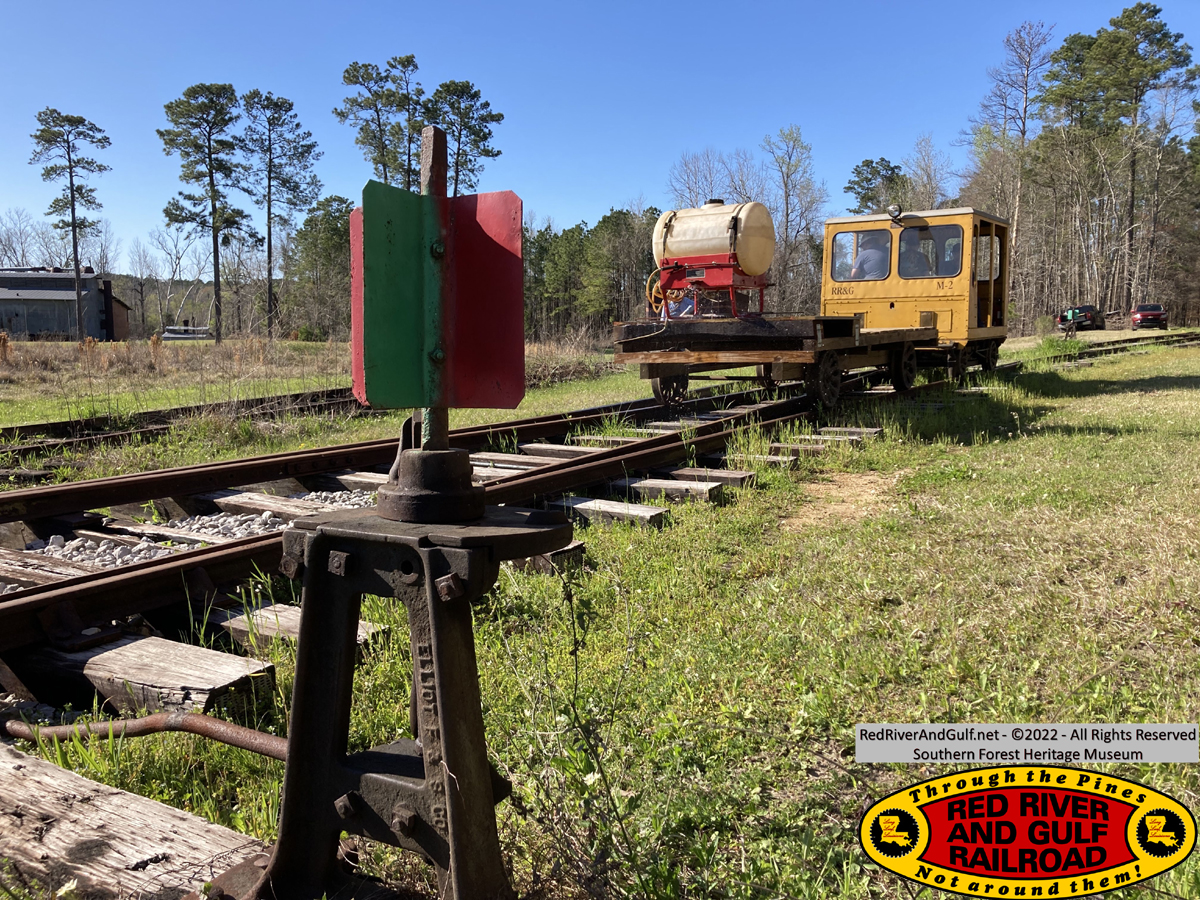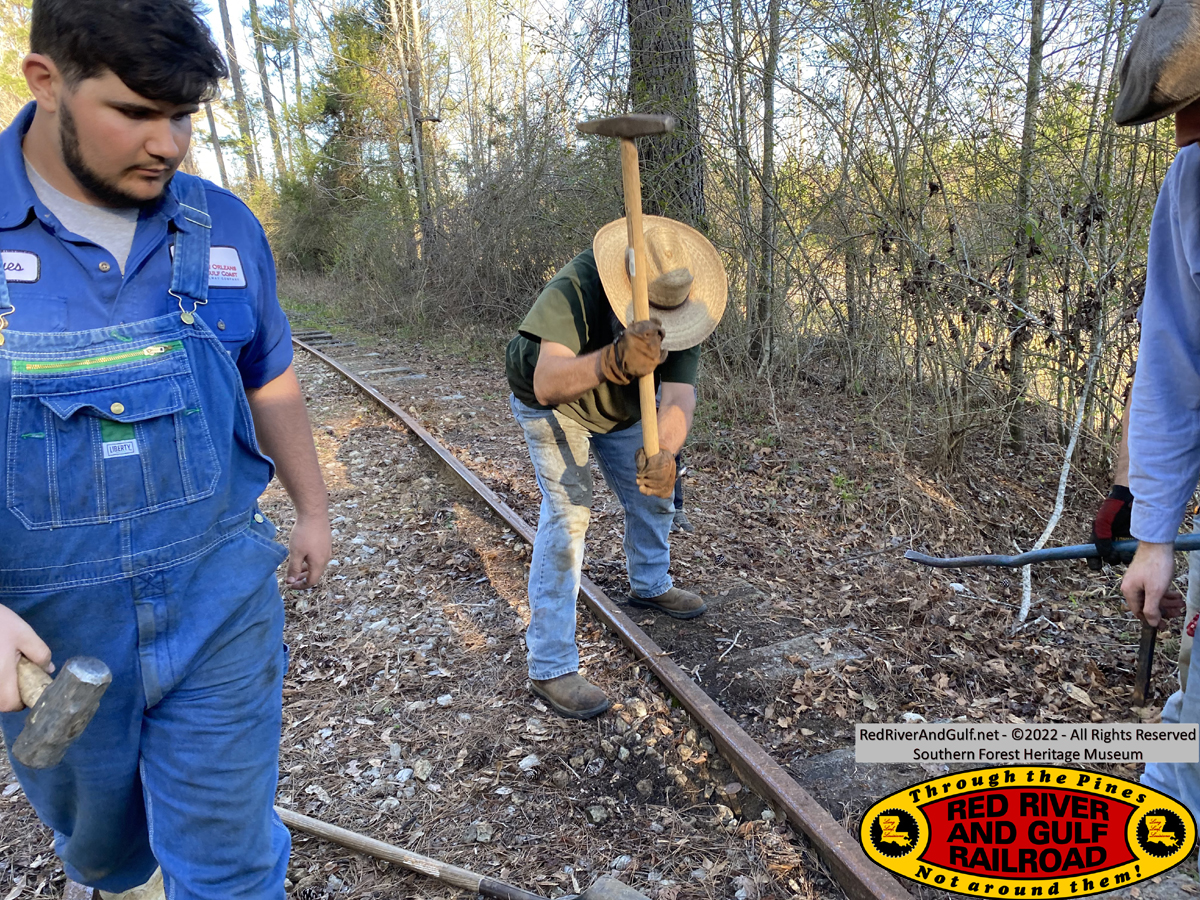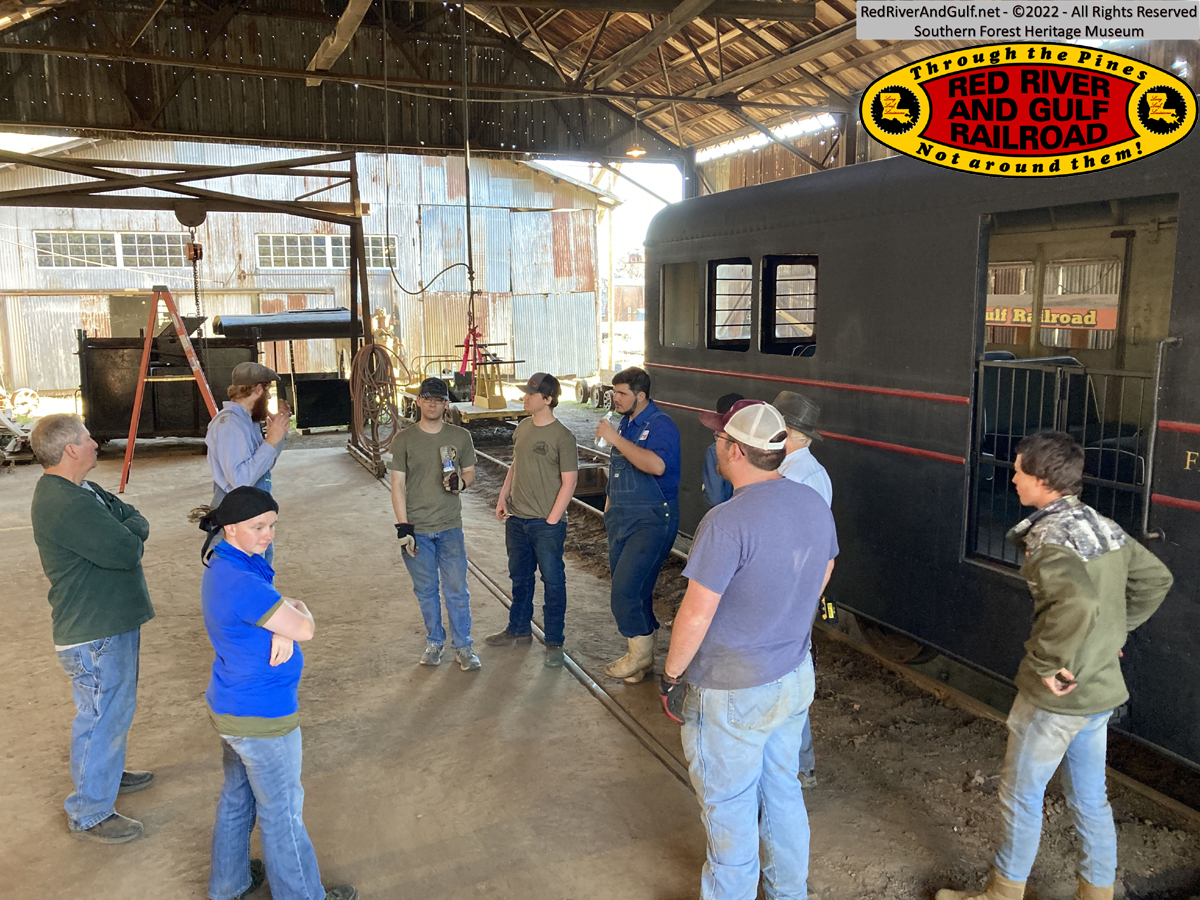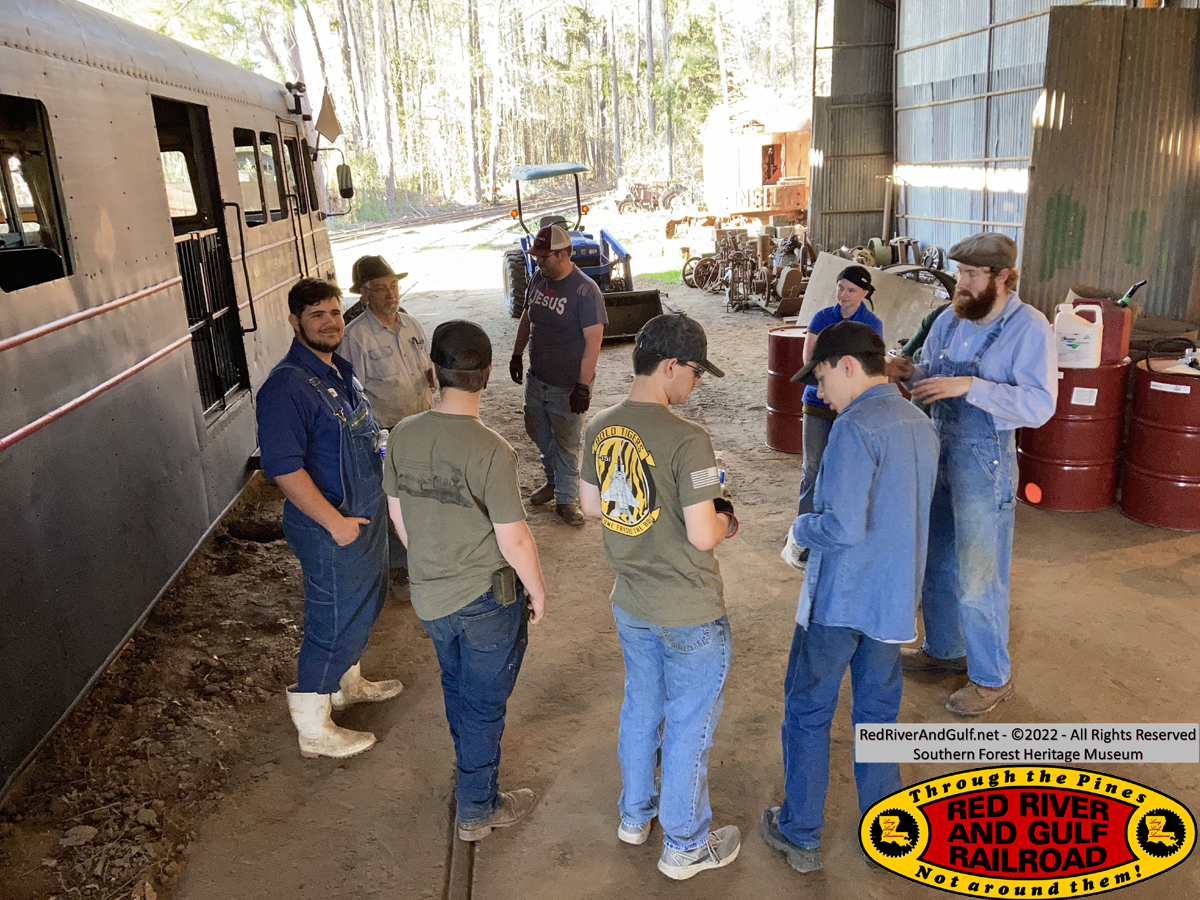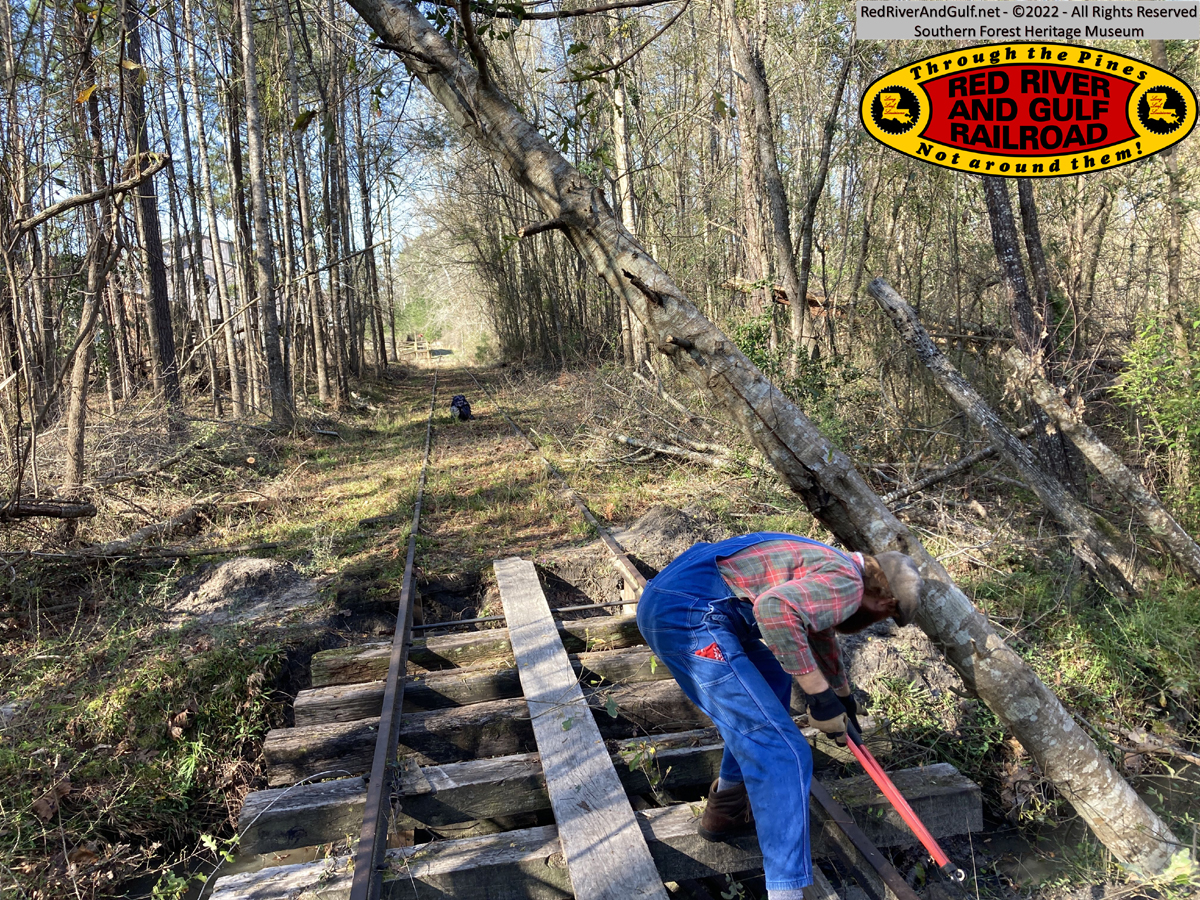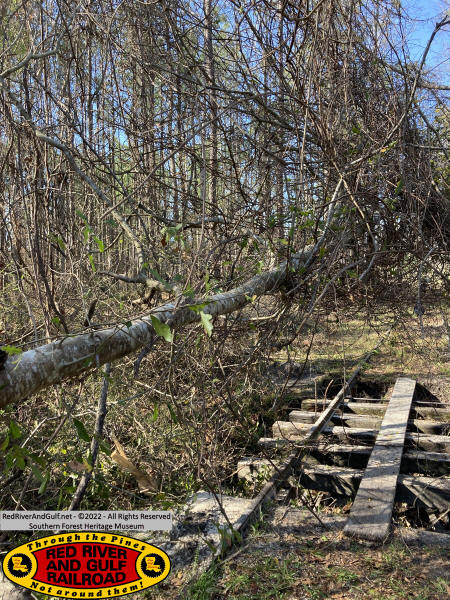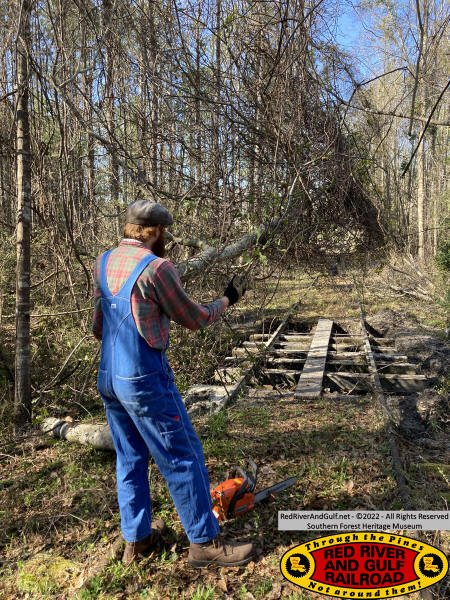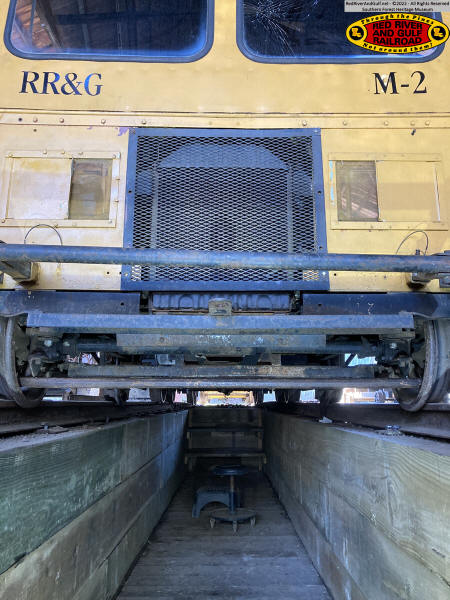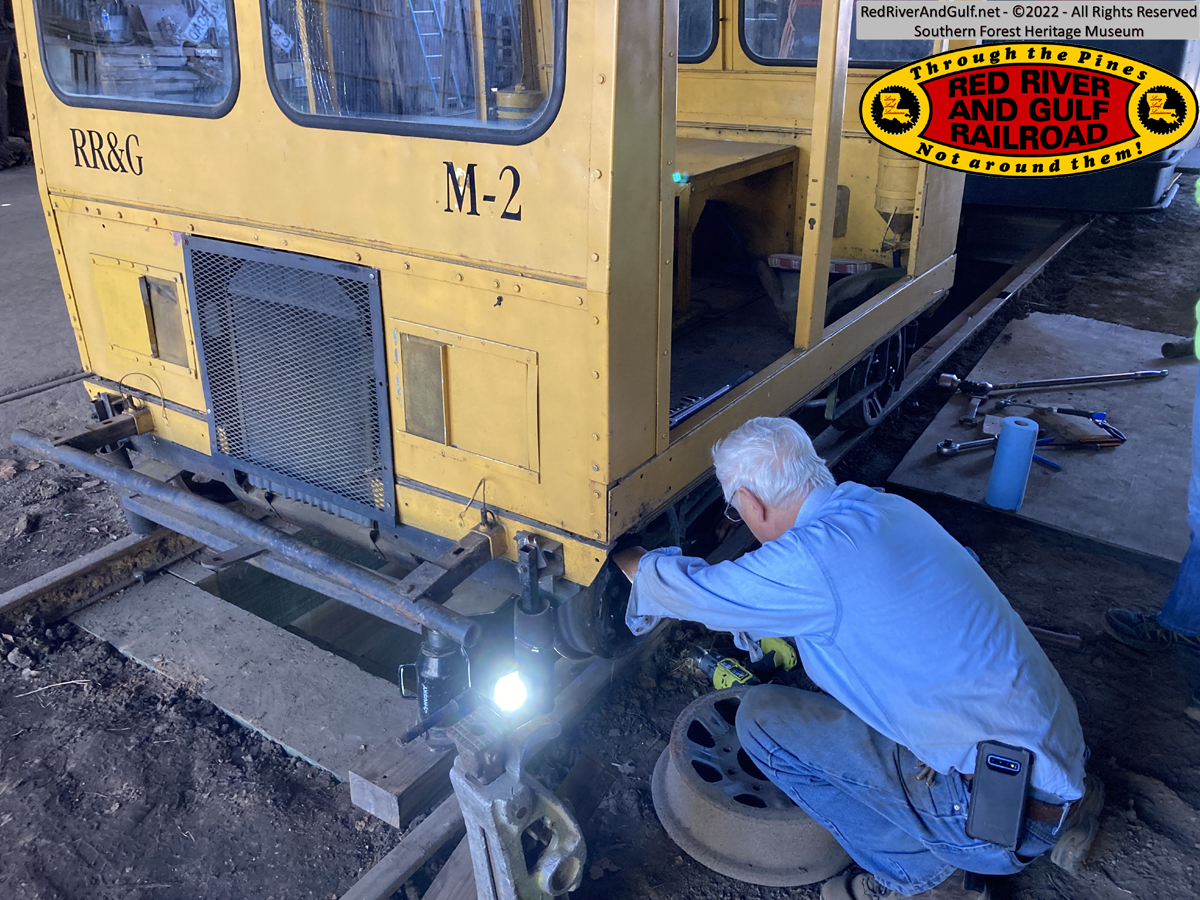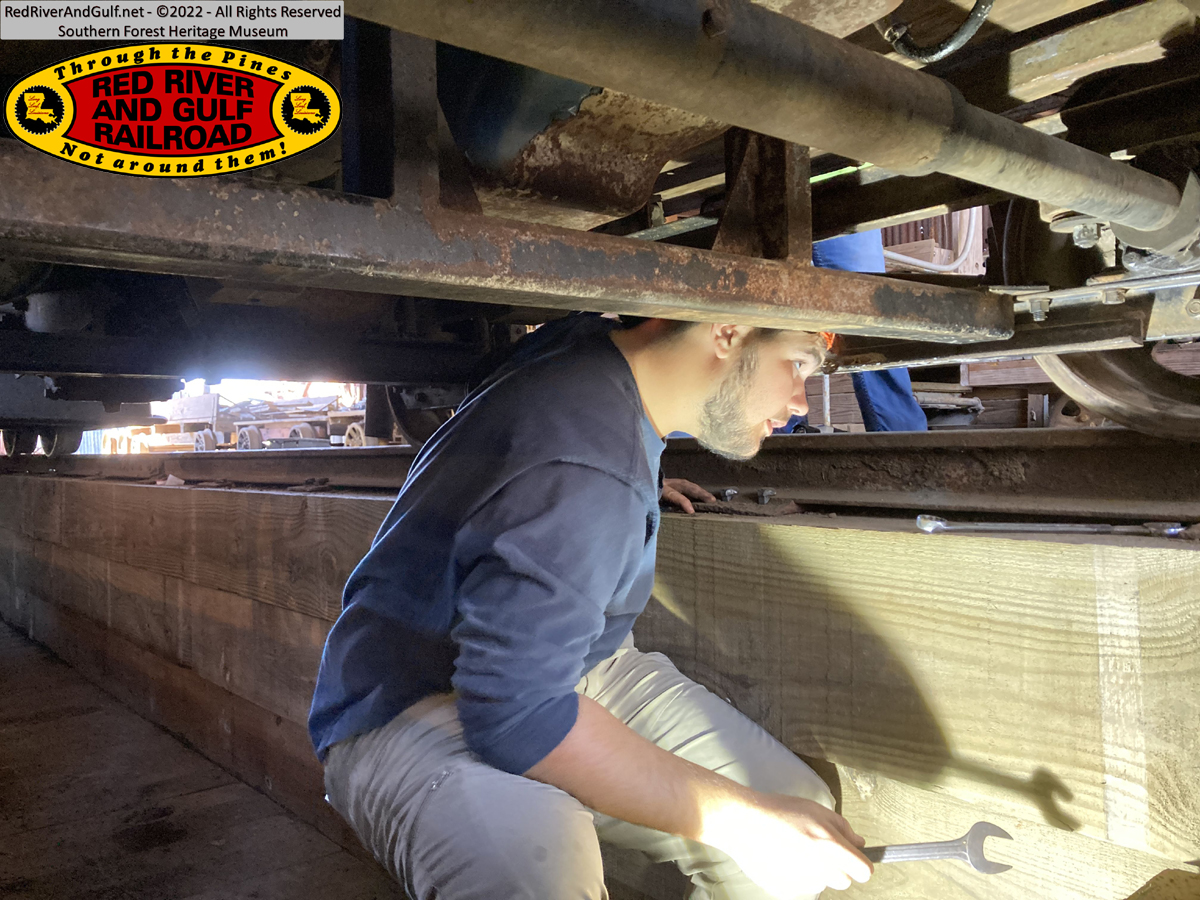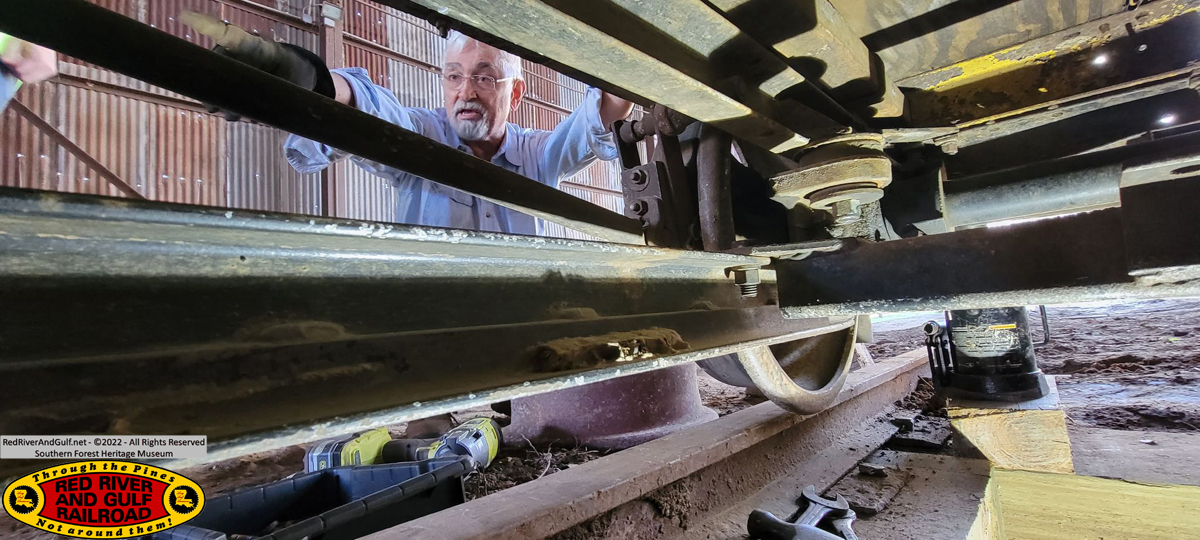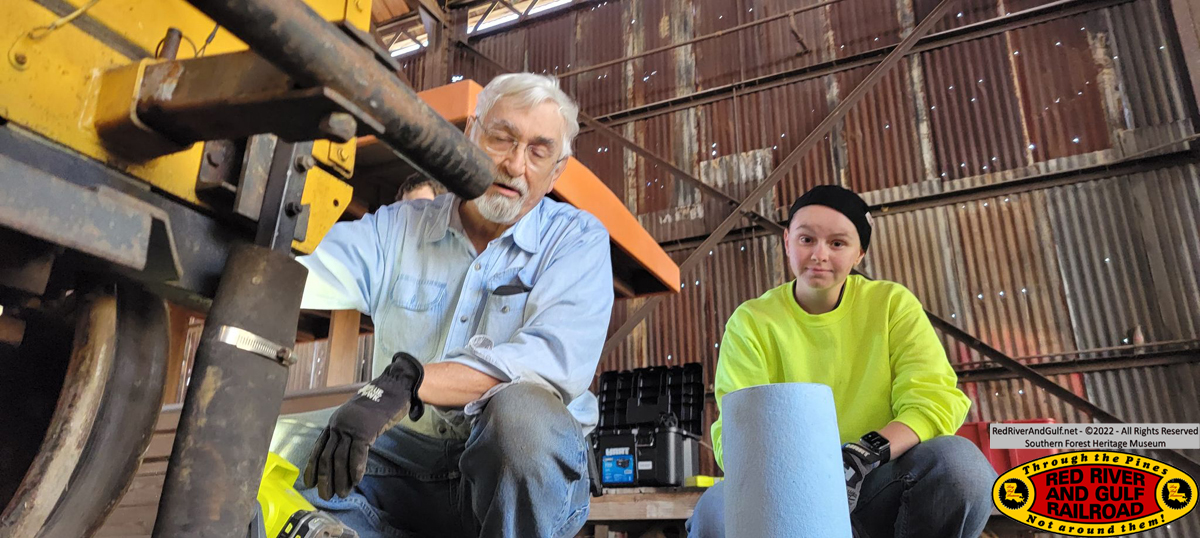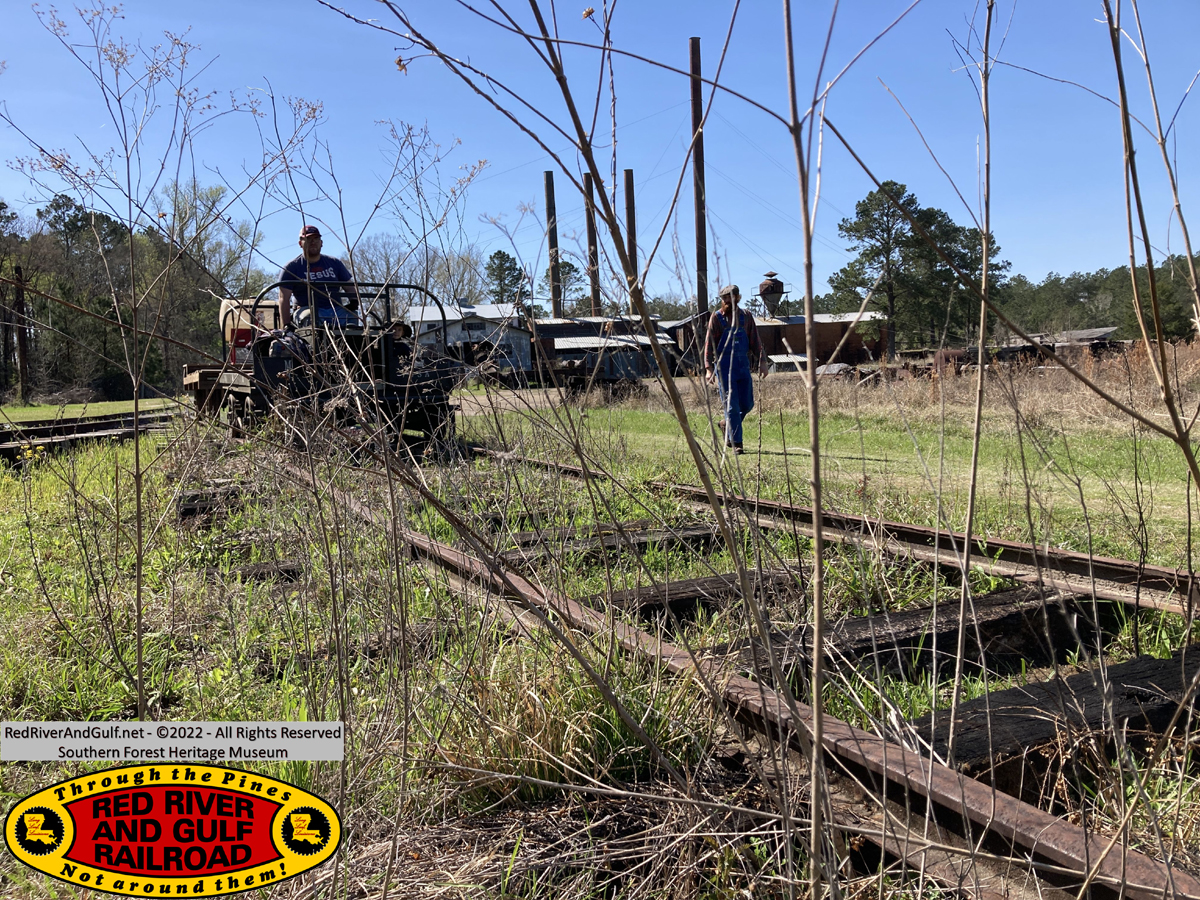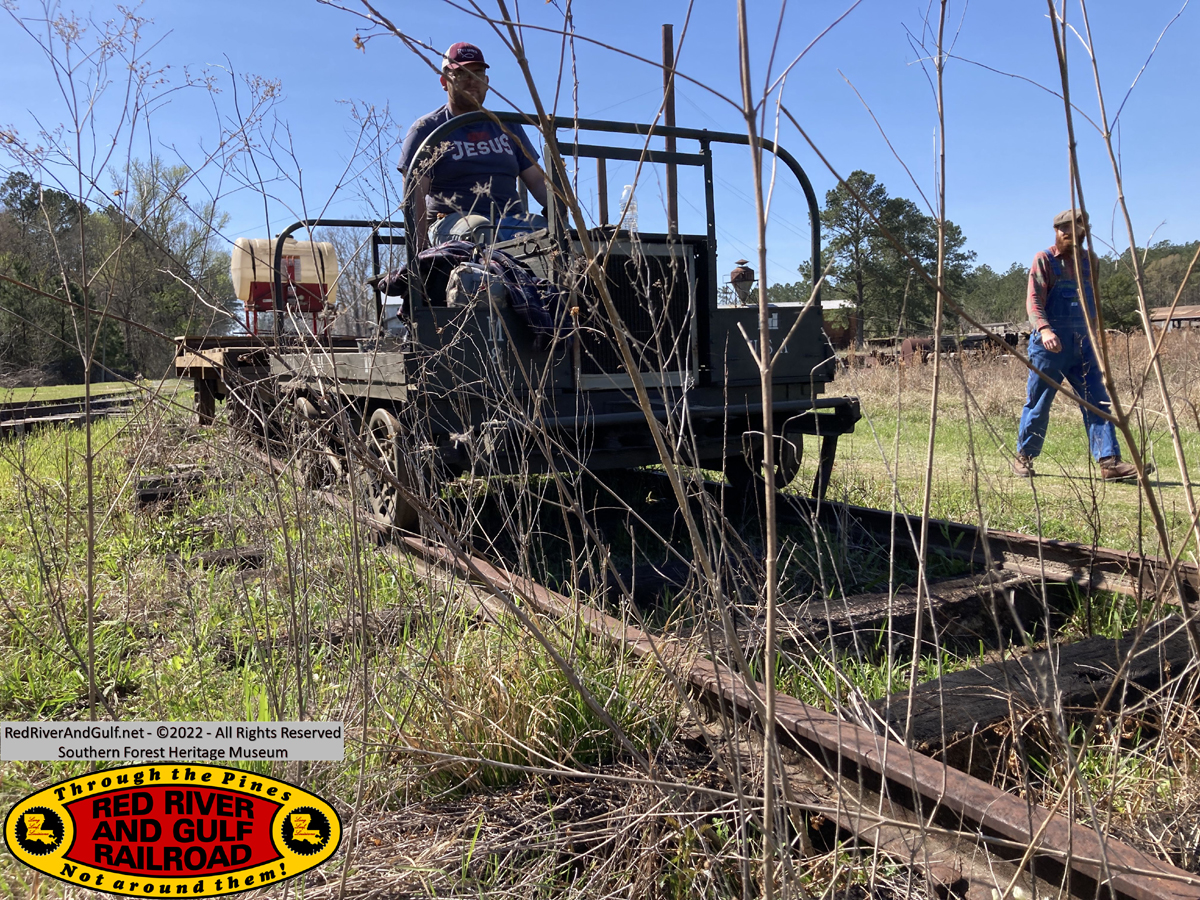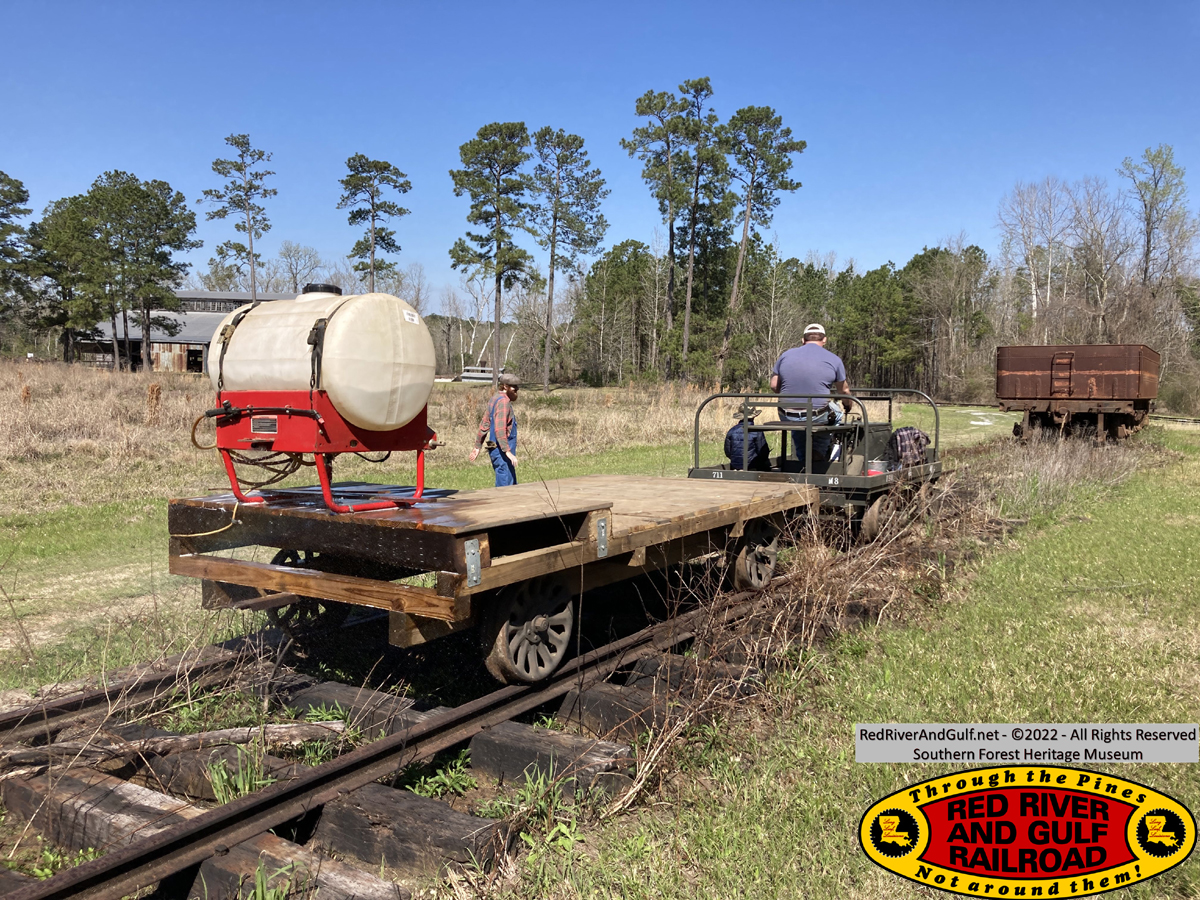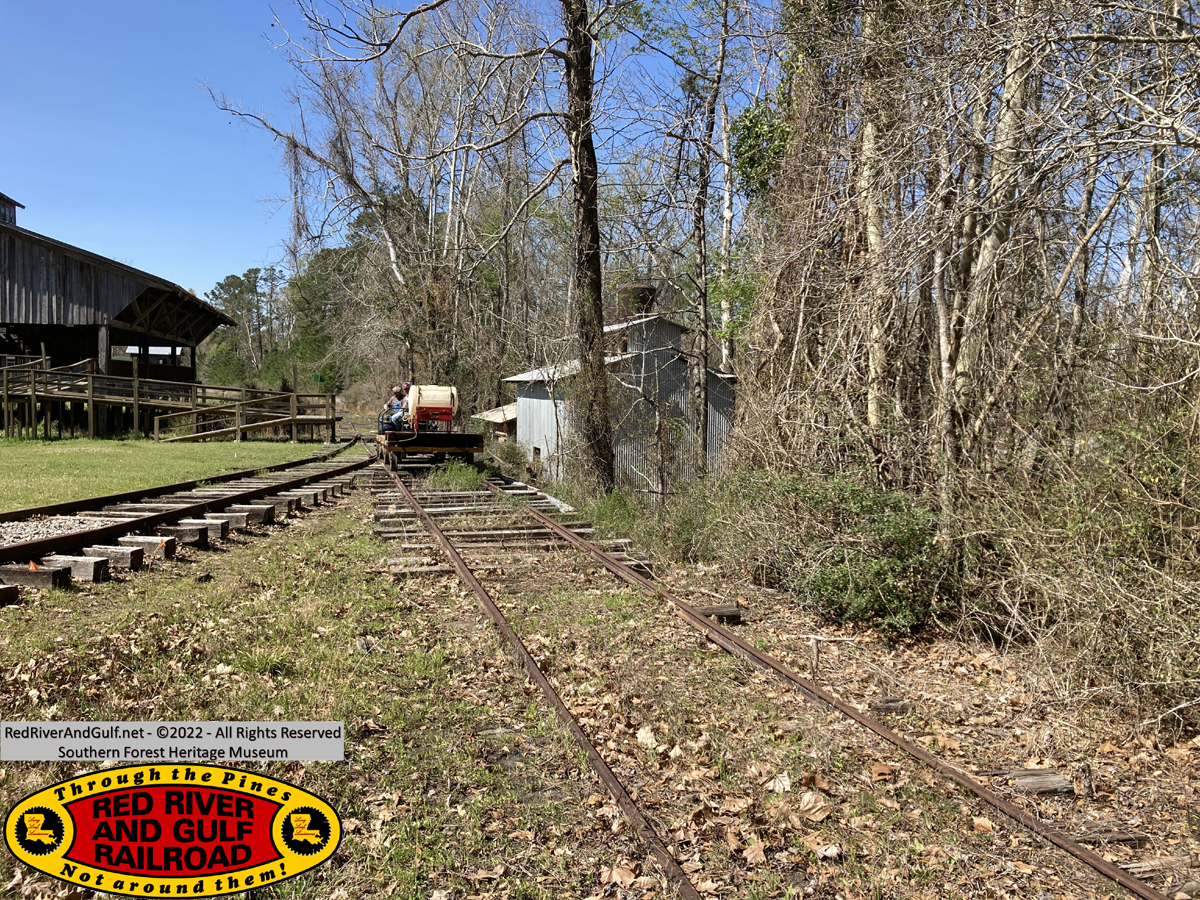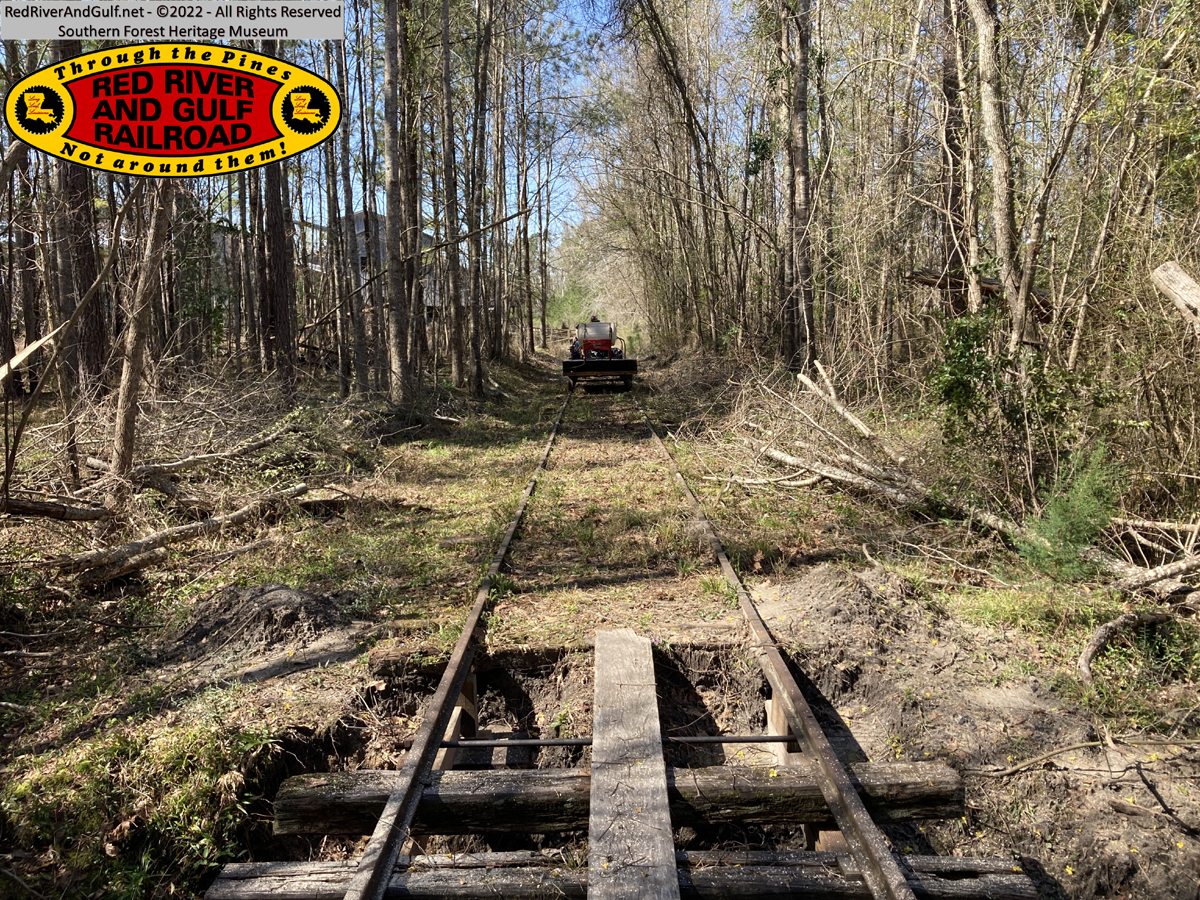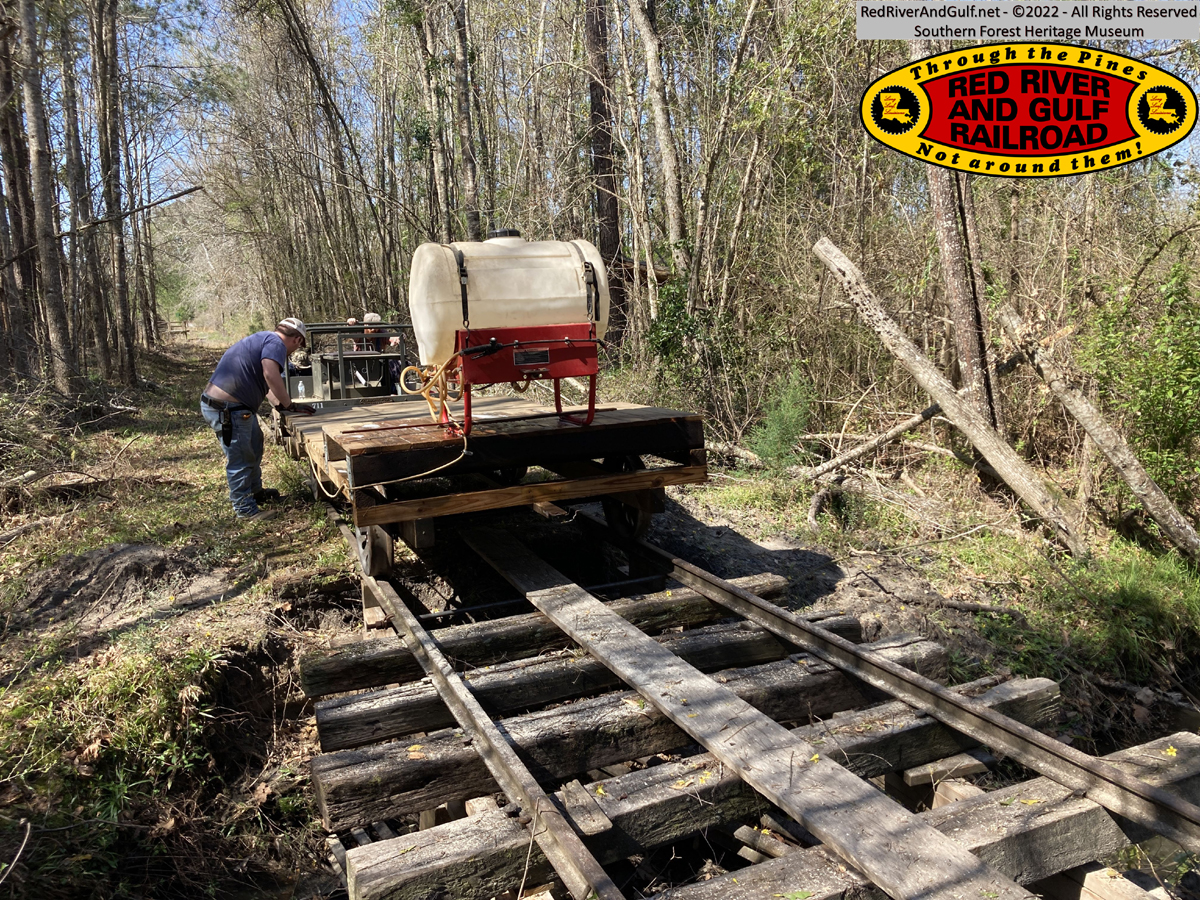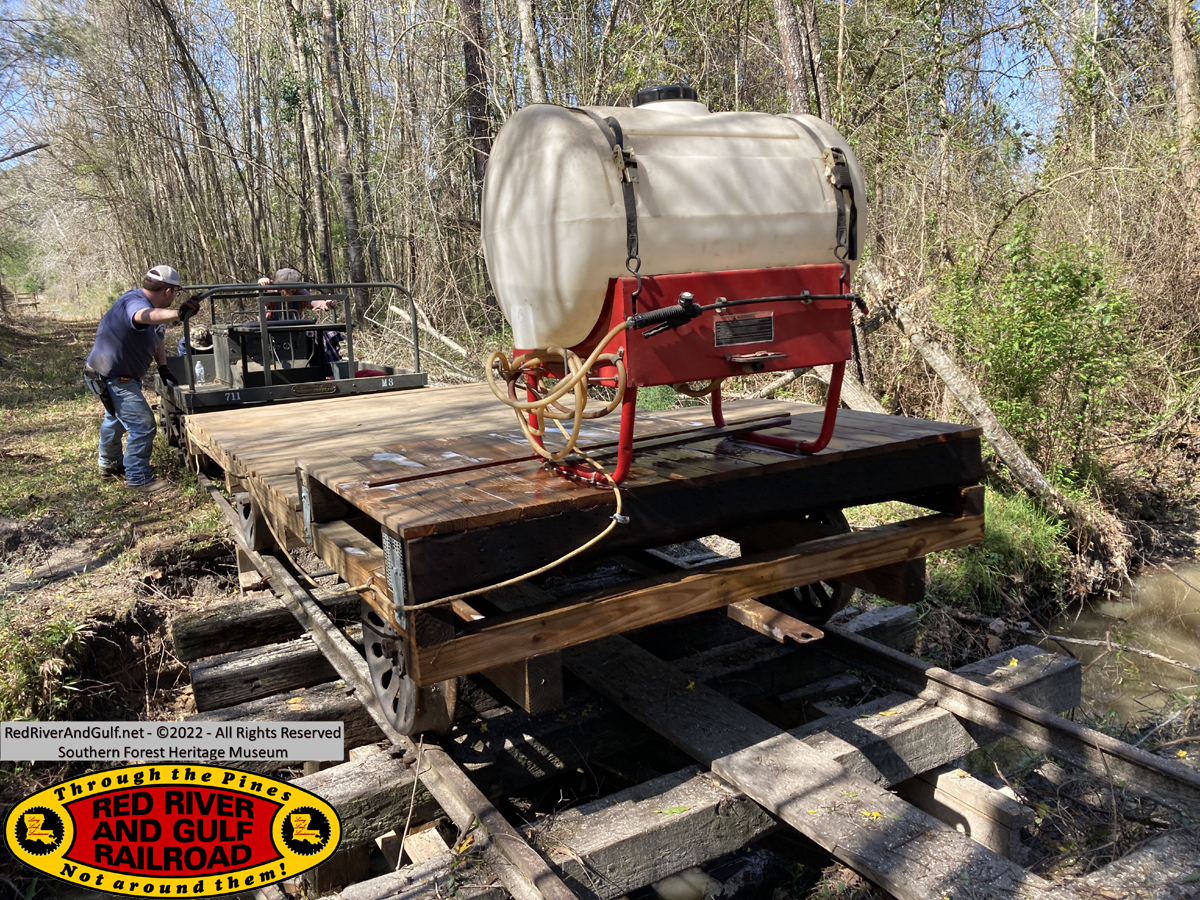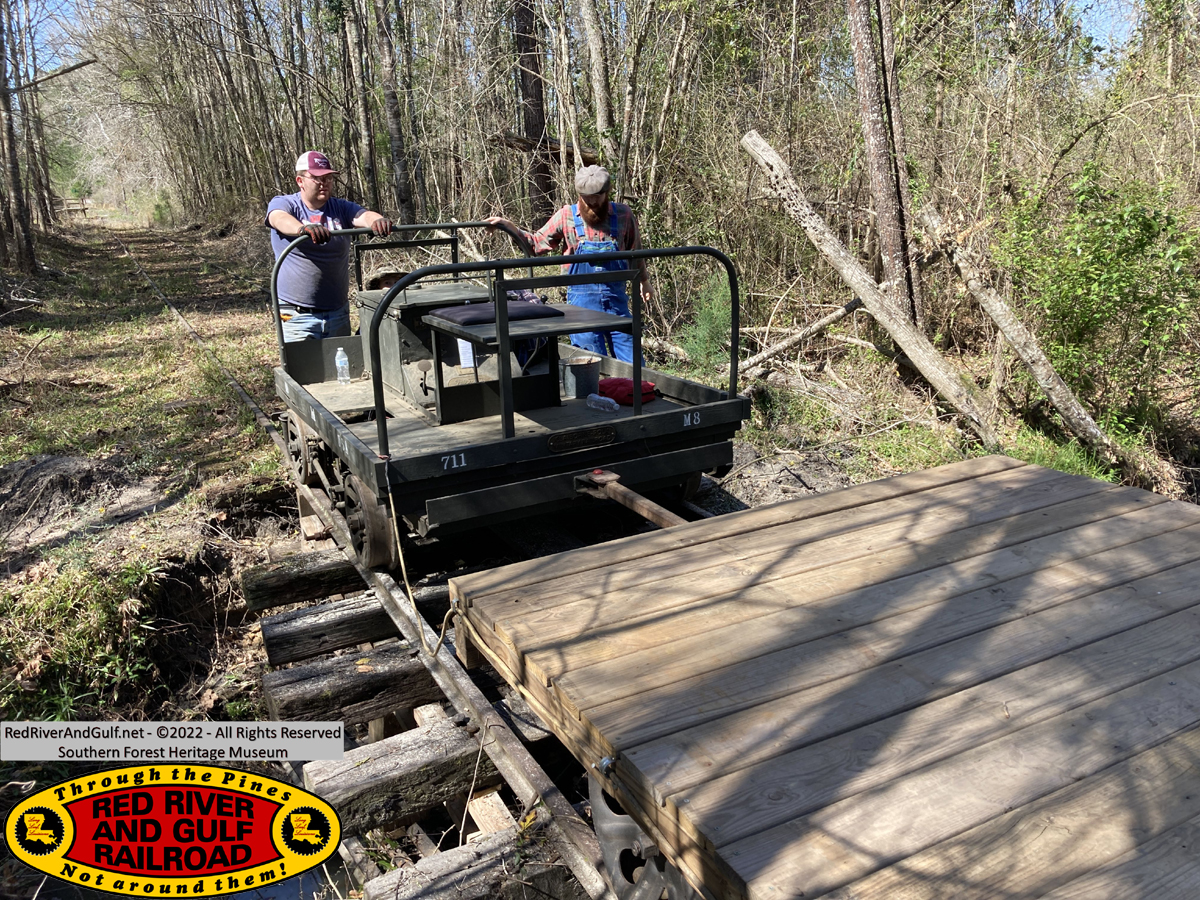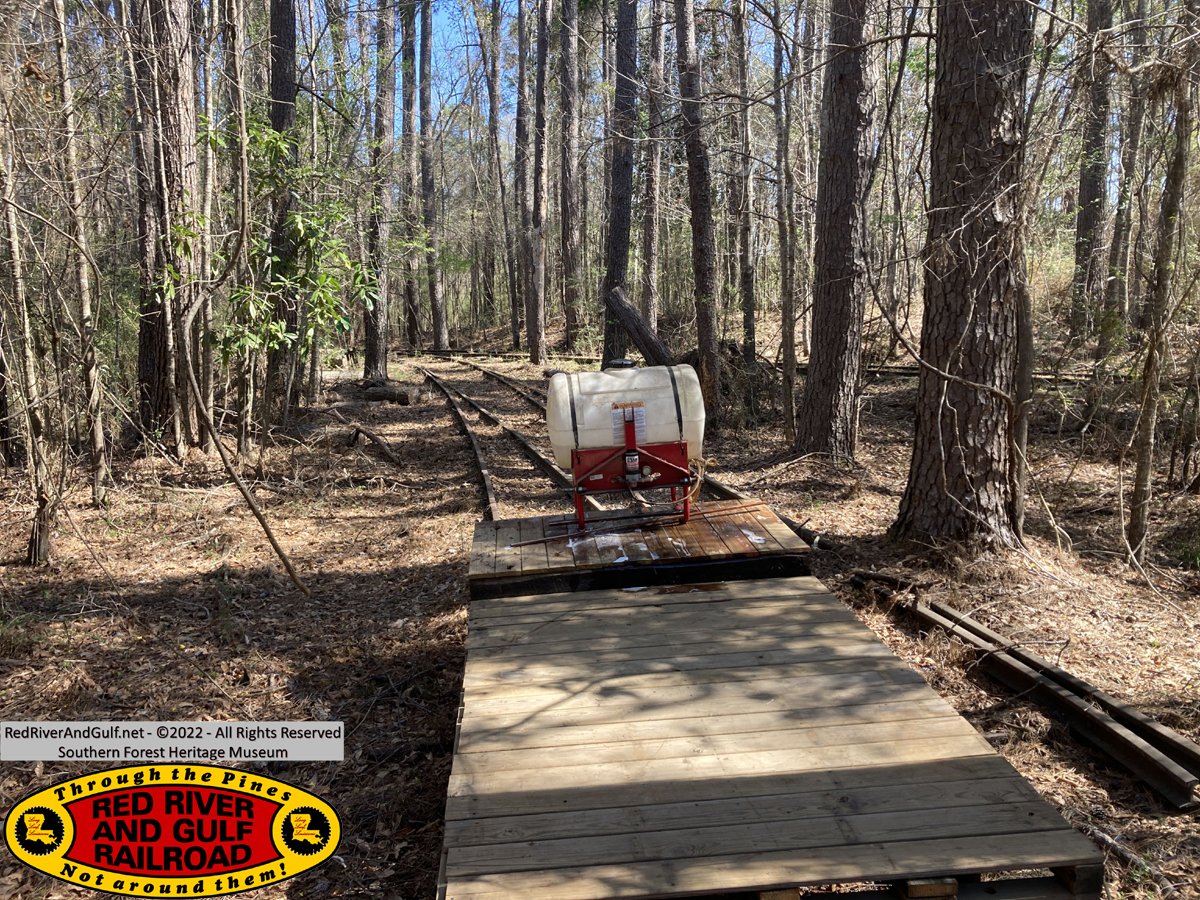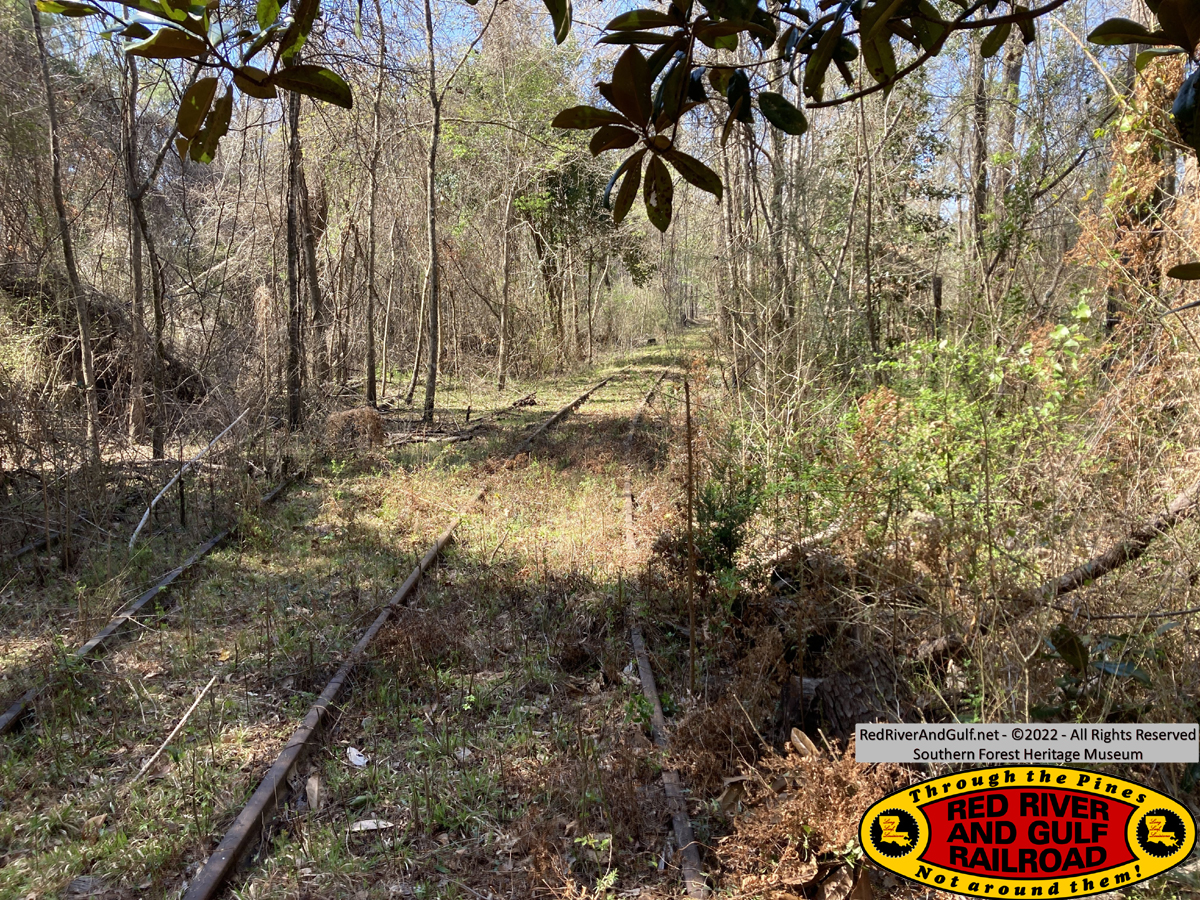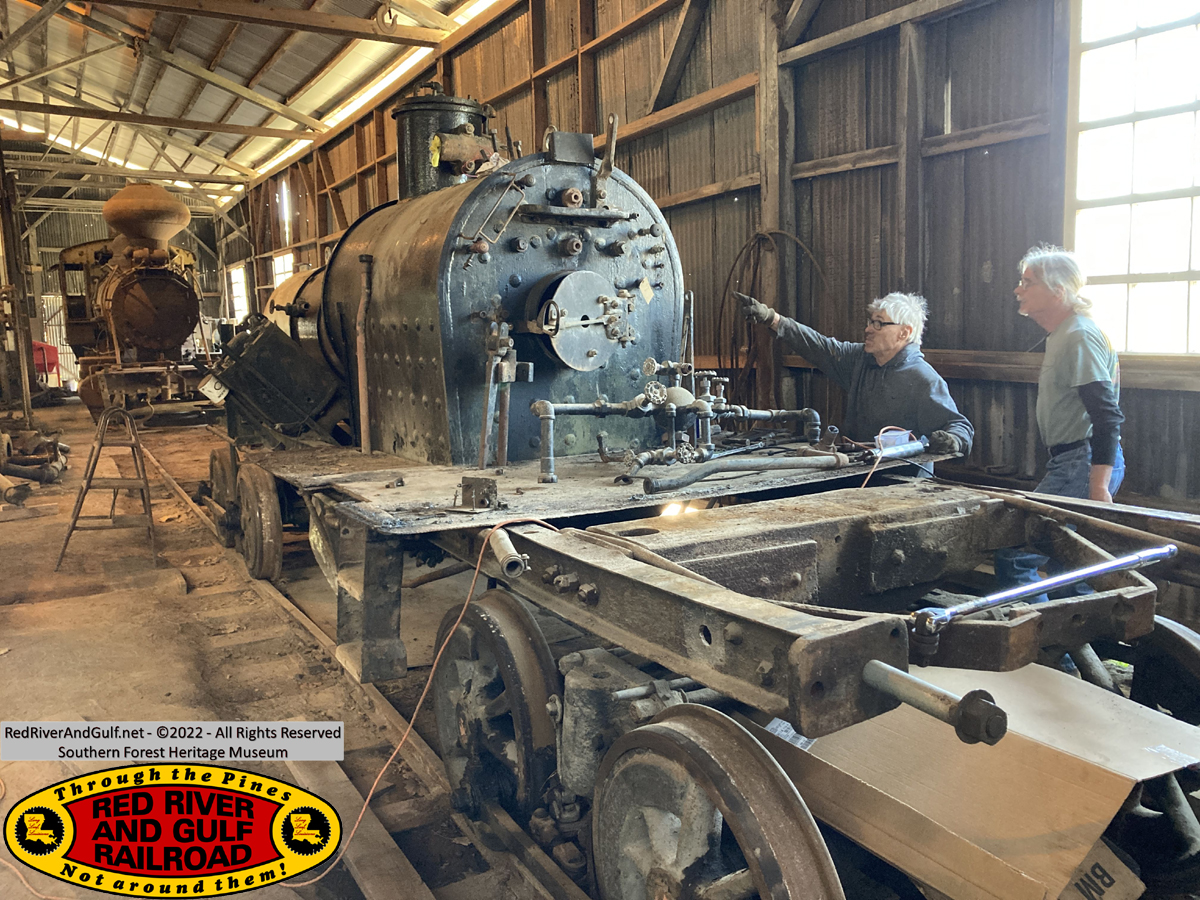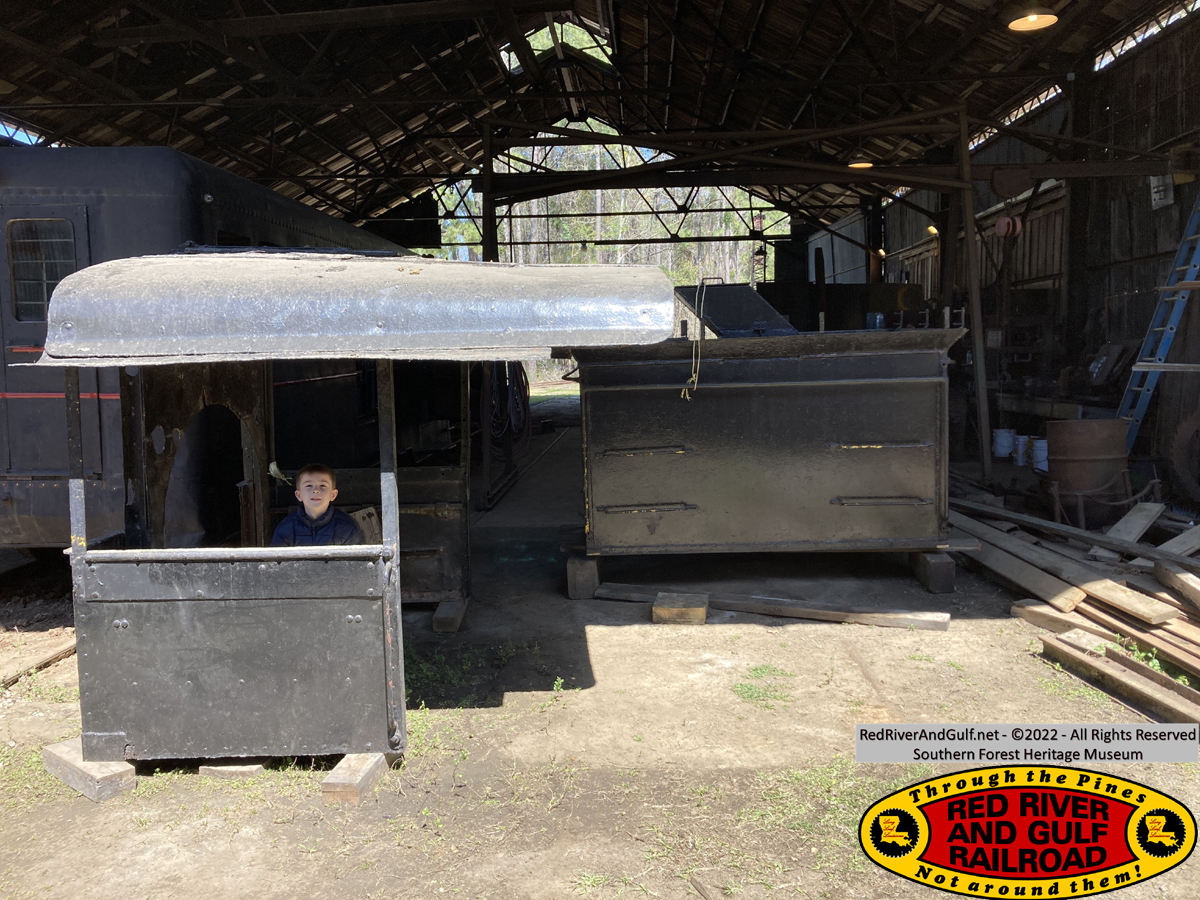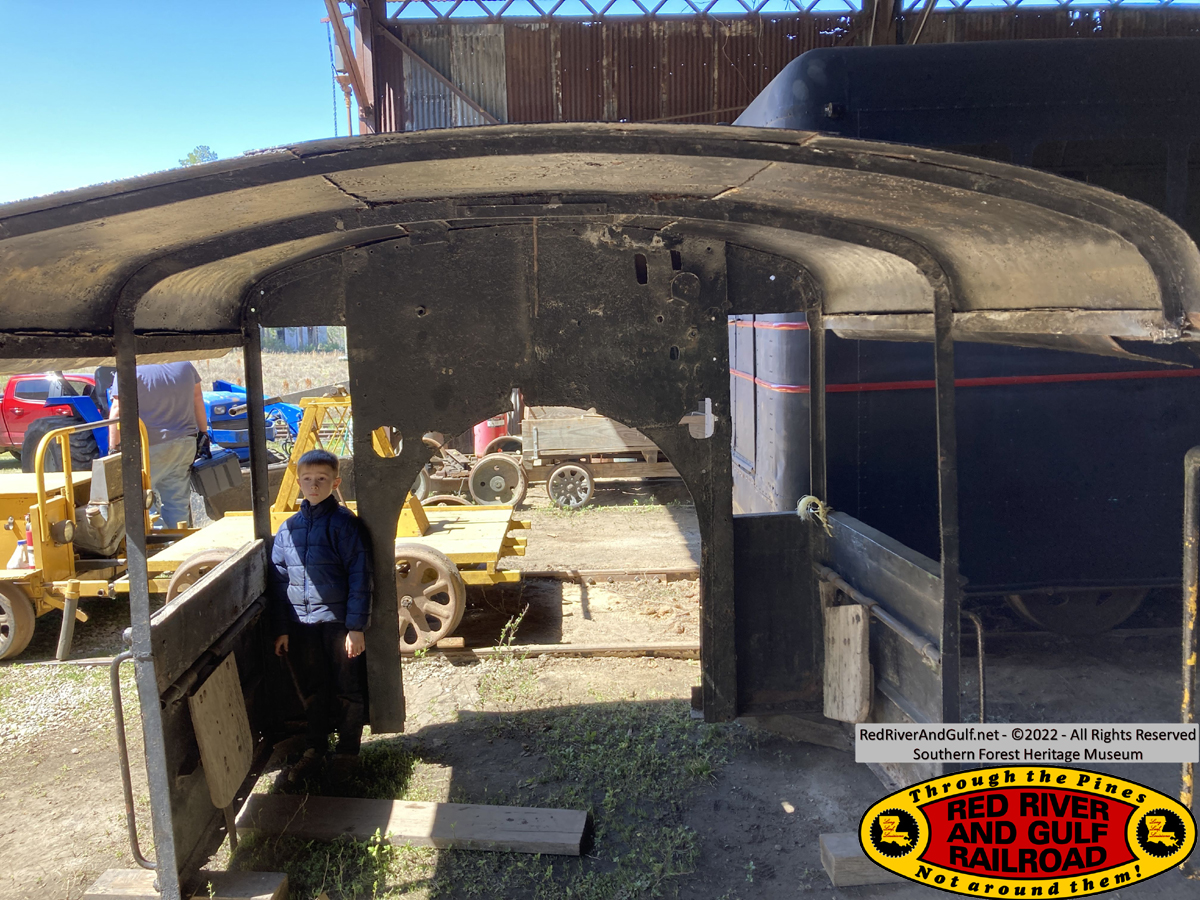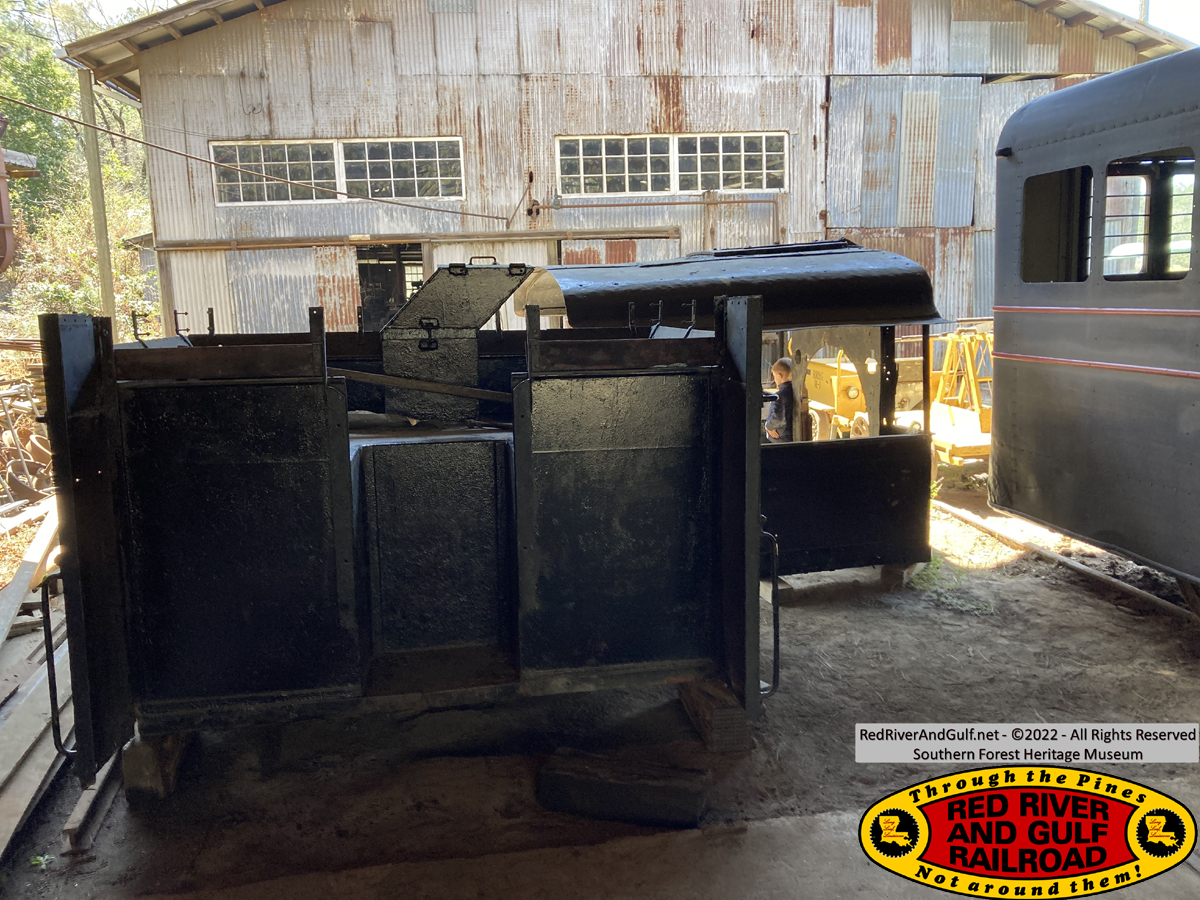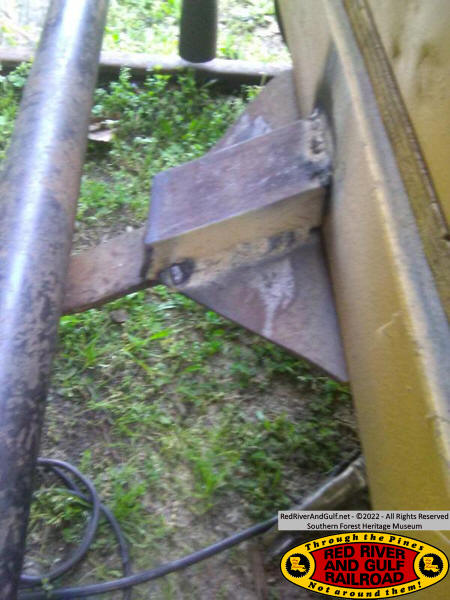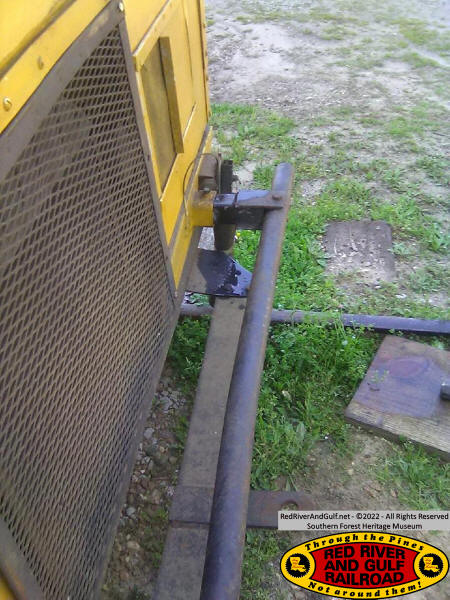|
Volunteer
Railroaders:
1. Chuck L.
2. Don F.
3. Mike M.
4. David H.
5. Jason
6. Noah
7. Everett
8. Glen
9. Wimbley
10. Mike B.
11. Jacques
12. Carson
13. Clint
14. Andrew
15. Angela
16. Dwayne
17. Tucker
18. Jim B.
19. Doug R.
Accomplishments
- Engine House lead track
#2 switch repaired
- Final ties inserted for pit track
- Second stick of rail moved and joined over pit
- Pit track rail spiked down to gauge
- Track ballasted on both ends of pit and along sides of pit
- Second pair of steps built and installed in pit
- A-frame hoist area thoroughly cleaned, and chain hoist lubricated
- Herbicide instruction and spraying conducted
- Water tank and cab removed from Heisler
- Very successful marketing and promotion efforts at the Forest Hill
Nursery Festival
Before the Weekend
Chuck and Don returned to
continue work in the naval stores building. They have completed the
curved wall for the resin bucket display on a tree trunk. A tree has
been selected at the museum and will become the “display” tree for this
exhibit. Chuck and Don also re-righted the museum entrance sign that
blew over in strong winds. They staked it into the ground to prevent it
from blowing over again.
Mike Miller and David Hamilton were
at work on the Heisler earlier in the week. With the water tank and cab
separated from the frame, and the repairs complete to the museum’s big
Hyster forklift, they lifted off both the water tank and then the
locomotive cab from the Heisler. This was accomplished by rolling the
Heisler out from the Machine Shop into the open space between the
Machine Shop and the Engine House, allowing the Hyster forklift to come
in close for the lift. Additionally, they moved several motorcar wheels
and the old M4 front truck out of the way for clear movement of
equipment. The tank and cab were placed on wood blocks in the Engine
House for temporary storage.
Friday
After the executive committee meeting, Mike M. and Everett headed up to
Shreveport to inspect a 10-ton Plymouth locomotive that was for sale.
Everett and the owner had been in correspondence since February
regarding the sale of the locomotive. With funds successfully raised
between board members, museum members, and volunteers, and after an
inspection in person, the locomotive was successfully purchased. The
next step is transportation to the museum and this portion is just about
all lined up. We are currently devising plans for repair, operation, and
long-term maintenance of this locomotive. It will be a great fit at
Longleaf as it will give a safe manner to move around equipment such as
steam locomotives, railroad cars, and railroad logging equipment. We
will keep everyone posted of this major development. Thank you to
Everett for heading up this effort and managing the logistics.
Saturday
With a beautiful Louisiana day, a donated booth spot for the museum to
use at the annual Forest Hill Nursery Festival was arranged with the
help of board member Sam Echols. This is a local festival
celebrating the large tree and plant nursery industry in and around
Forest Hill, Louisiana. All day Saturday the museum was promoted through
flyers, brochures, and books, and by selling T-shirts, books, admission to the
museum, and train rides. Doug, Jim, Karla, and Robin worked the booth
and reported a big success both at the festival and at the museum.
Visitors and tour guides were plentiful all-day Saturday at the museum
because of this promotion. Well done everyone and thank you to those
that help set this up!
We like to recognize and thank Jacques for donating four used 55-gallon
drums with one having a few gallons of used oil. The drums are in great
condition and can be used for a whole host of purposes. The used oil is
also handy too. Thank you, Jacques!
Mike M. was “up front” at the museum Saturday. He was making upgrades to
the museum office computers and networks and working at the Naval Stores
building. Chuck and Don finished the curved exhibit corner in the Naval
Stores building the week prior and Mike continued the interior work.
“Up the hill” at the Engine House, the volunteers split into several
teams. Team #1 of Everett, Angela, Andrew, and Dwayne went to work on
the switch for Engine House track #2. Last week, one wheel set of the
rear truck of the M4 derailed backing into the Engine House. Team #1
made the needed repairs by installing more washers on the switch bars to
ensure smooth contact between the switch points and the stock rail. When
Gerald brought the M4 up for the day in the late afternoon, he went over
the switch several times for testing. The switch tested well, and the
report was that it was “quite smooth” and “much improved.” Everett has
completed a detail report on the derailment and the corrective action
taken.
Using his tractor and well-devised clamp-and-plywood-handle lifting
system, Glen moved the leftover timbers from the pit construction down
to the finished lumber shed for storage. The large 10-foot timber has
been flagged for use at the Planer Mill while the remaining small pieces
will be used for other projects as needed.
As the timbers were being moved and the switch was being repaired,
another team of MB, Jason, Wimbley, Jacques, Carson, Clint, and Tucker
inserted the final remaining ties for the pit track on the back end of
the pit track. Jason used a chainsaw to saw off about 3 inches on each
tie so they could fit into the track space between the concrete jack
pads. Two concrete pads line both sides of the pit track beyond the pit
itself. Using picks and shovels, the ties were placed into position.
With the timbers moved and the final ties inserted, Glen used his
tractor to move and position the last pieces of rail over the pit. The
first joint was successfully connected in good time; however, the second
joint required some maneuvering of the rail. Fortunately, a pair of
joint bars with the exact bolt hole spacing needed were located and
pressed into service.
With the switch repair team finished and all the rail in place on the
pit, the first rail (on the tool room side) was lined up and the spiking
began. This first rail would be spiked down and then the second rail
would be gauged and spiked down based off this one. With fresh timbers
and drilled-out holes, the spikes were very easily driven down into the
pit wall timbers. Before breaking for lunch, the happy group gathered to
take a celebratory photo in the pit.
Throughout the day, many tour groups and visitors were all over the
museum. Angela and Andrew did fine work giving guided tours around the
museum, answering questions, and helping connect potential volunteers
with our volunteer project leaders.
After lunch, the crew finished the gauging and spiking of the pit rails.
The next task was ballasting the track on both ends of the pit and along
the wall timbers. We pulled dirt from the dirt pile behind the Engine
House using the museum tractor. Ballasting makes the track and
surrounding area more level and stable to work in and around. We moved
about a dozen buckets-full of dirt for ballast.
An Arkansas & Louisiana Missouri Railroad steam locomotive whistle was
donated to the museum by long-time volunteer Louis Saillard. (Yes,
that’s the right name of the railroad when they operated steam
locomotives). With the ballasting ongoing, Jacques, Wimbley, and Carson
had run into Oakdale to pick up some hardware to rig the whistle up to
the air line in the shop. As the ballasting on the pit wrapped up, they
set to test the whistle, but the valve was not seated quite right, so it
will be little longer before we hear that whistle blow. We thank Mr.
Saillard for his kind donation!
A herbicide instruction and spraying course was conducted for the
volunteers with the pit project and the whistle effort finished for the
day. Safety, mixing, and spraying operations were included and with a
full tank mixed up of herbicide solutions, hands-on training was held
with each volunteer running the M2 and the spraying in alternating
turns. Between Saturday and Sunday, all trackage that the motorcar could
reach was sprayed and heavy vegetation portions received multiple
spraying passes. This covered the main loop, the wye tracks, the line to
Sandersville (up to the washout), the Engine House leads, the storage
track, and spraying with the tank wand near switches.
During the spraying, Everett, Glen, and Jacques continued work up on the
Engine House. A second set of steps were installed at the back of the
pit (giving steps on both ends), the concrete floor area was cleaned up
of sawdust and dirt, the A-frame chain hoist flangeways were cleaned
out, and the chain hoist was lubricated. Mike Brown continued work on
his Heisler.
The spraying was moving along well and while going around the loop back
to the Engine House, a minor derailment occurred. While moving behind
the old dry kilns at only 5 mph, the M2 gave a slight bump and was off
the rails. No one was injured. The sprayer car did not derail. We had
plenty of hands available, so the M2 was lifted back onto the rails.
With the gauge and other tools, we checked the gauge in the entire area
but found the track was in good shape and the gauge within tolerance
(was 56 inches in spots). We pulled outside spikes, gauged to 56 1/2
inches, inserted new spikes on the inside of the rail, and did double
spikes on the inside for four crossties. This spot was before the prior
derailment spot, so this derailment was not in the same spot. To be
sure, we checked the gauge all up and down this track area and ensured
no ballast was near the rail head. After the checks, the track was found
to be in gauge and the flangeways along the railhead were all clear.
A debriefing was held at the end of the day to recap accomplishments,
answer questions, address some struggles, and to make plans for Sunday.
Sunday
Sunday’s primary activities were inspecting the M2 wheels and finishing
the spraying operation. Upon close inspection, a false flange had worn
on the front M2 wheels, causing these false flanges to be a quarter inch
too far outward. Jacques, Everett, and Angela, with some later help by
Jason and Dwayne, replaced these front two wheels with two new ones. The
old wheels will be retained and can be machined back into good order.
The pit was well used in this situation, with Jacques below helping with
the wheel changes. Grease was also applied in the respective needed
positions and the brakes received an adjustment to keep them in good
order. A bottle jack was also used to straighten the back tow hitch.
A second team of Andrew and Dwayne took M8 and the sprayer car to spray
herbicide on the Sandersville branch up to the washout. A third team of
Jason and Tucker headed out with a chainsaw to remove a fallen tree on
the switchback track (Planer Mill bypass). With that tree removed,
another tree was spotted with a severe lean over the Grigsby Gulch
bridge that was recently repaired. Jason and Tucker removed and cut up
this tree, even as thick vines held up a portion of the tree in the air.
We couldn’t have done that even if we wanted to! After safely removing
the tree, we remarked at the humor in the situation. With the trees
cleared, Andrew, Jason, and Tucker gave this track two heavy passes of
herbicide spraying.
Wrapping up the day, the crew replaced a 2x6 board at Engine House track
#2 switch that had rotted out. This board was inserted two years ago to
give stability to this switch stand and stock rail. The Engine House
garbage cans were emptied out into the museum dumpster using the
museum’s tractor.
On Sunday, Mike M. was doing more work at the Naval Stores building and
Mike B. was continuing work his Heisler, working on the brake lines and
the steam jam.
The weather was beautiful, the results were spectacular, a major project
is now complete, and the future looks bright! Thank you to everyone who
has contributed to all our success!
Saturday, March 26
David Hearne Sr. used his fine skills and talents to complete some
repairs to the M2 motorcar. David used his floor jack and the museum's
torch to straighten out the square tubing. He jacked it up, heated the
tubing, and used the weight of the M2 to straighten the tubing. He then
tweaked the sides with a sledgehammer to remove the bulges in the
tubing. Once this was done, he lubricated the tubing with diesel and the
whole thing slid right back into place. No new pin holes needed. He used
his grinder to open the crack in the rear drawbar and welded it back up.
He then grounded it smooth, fabricated a stiffener from a piece of
channel laying around, and welded that over the top of the flat bar.
-Tucker "Who Dat" Baker
RR&G Road Master
|
